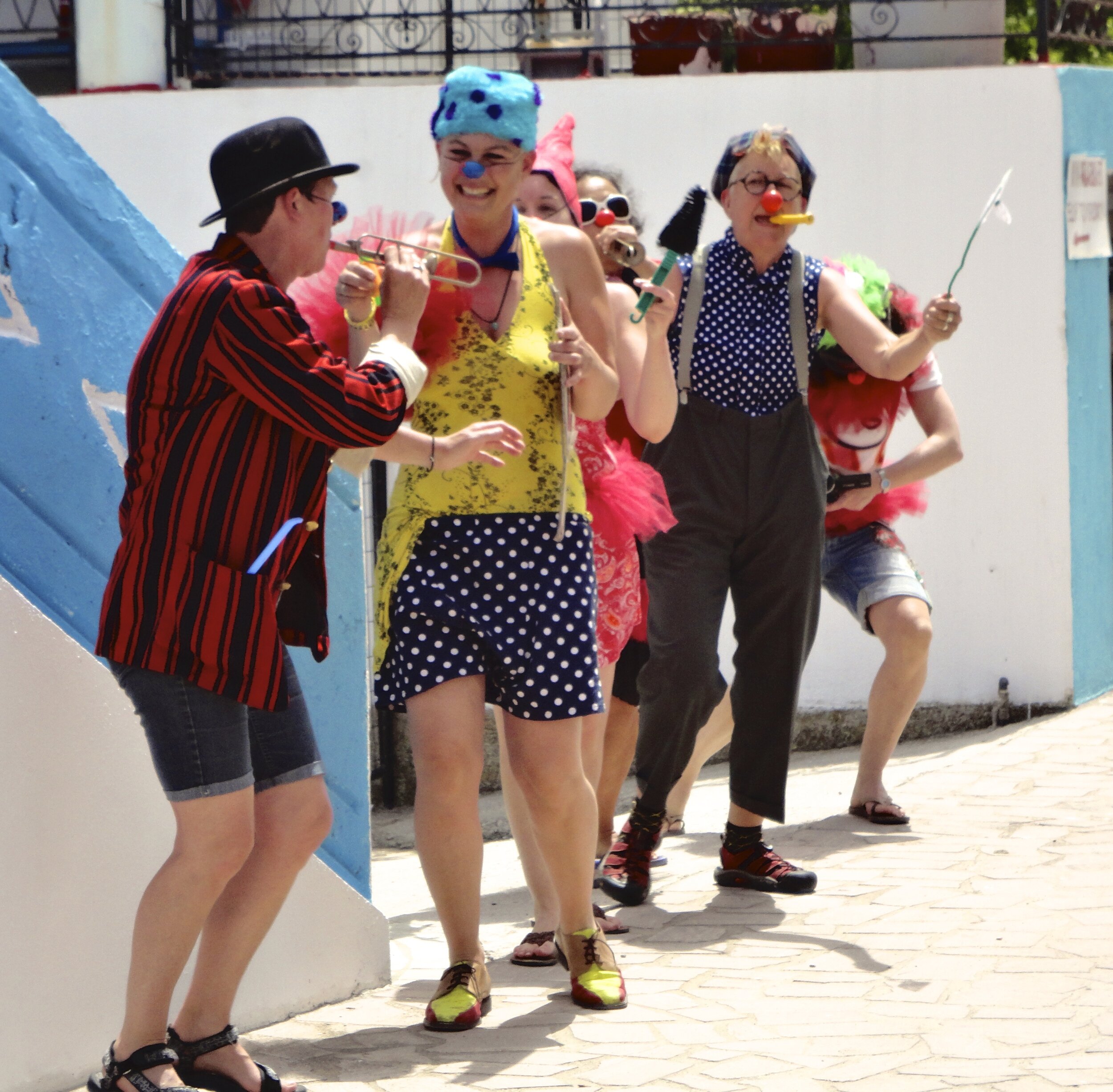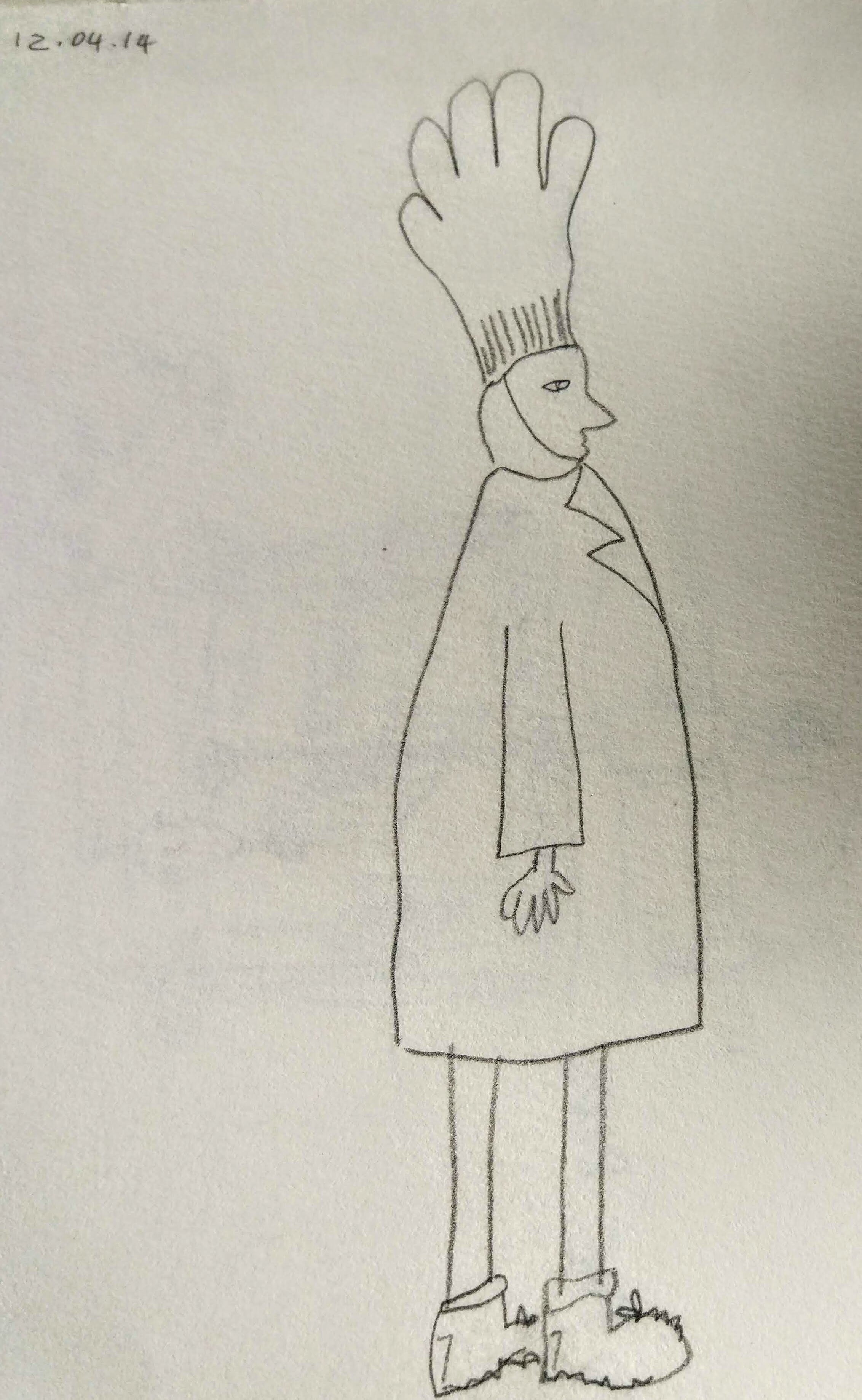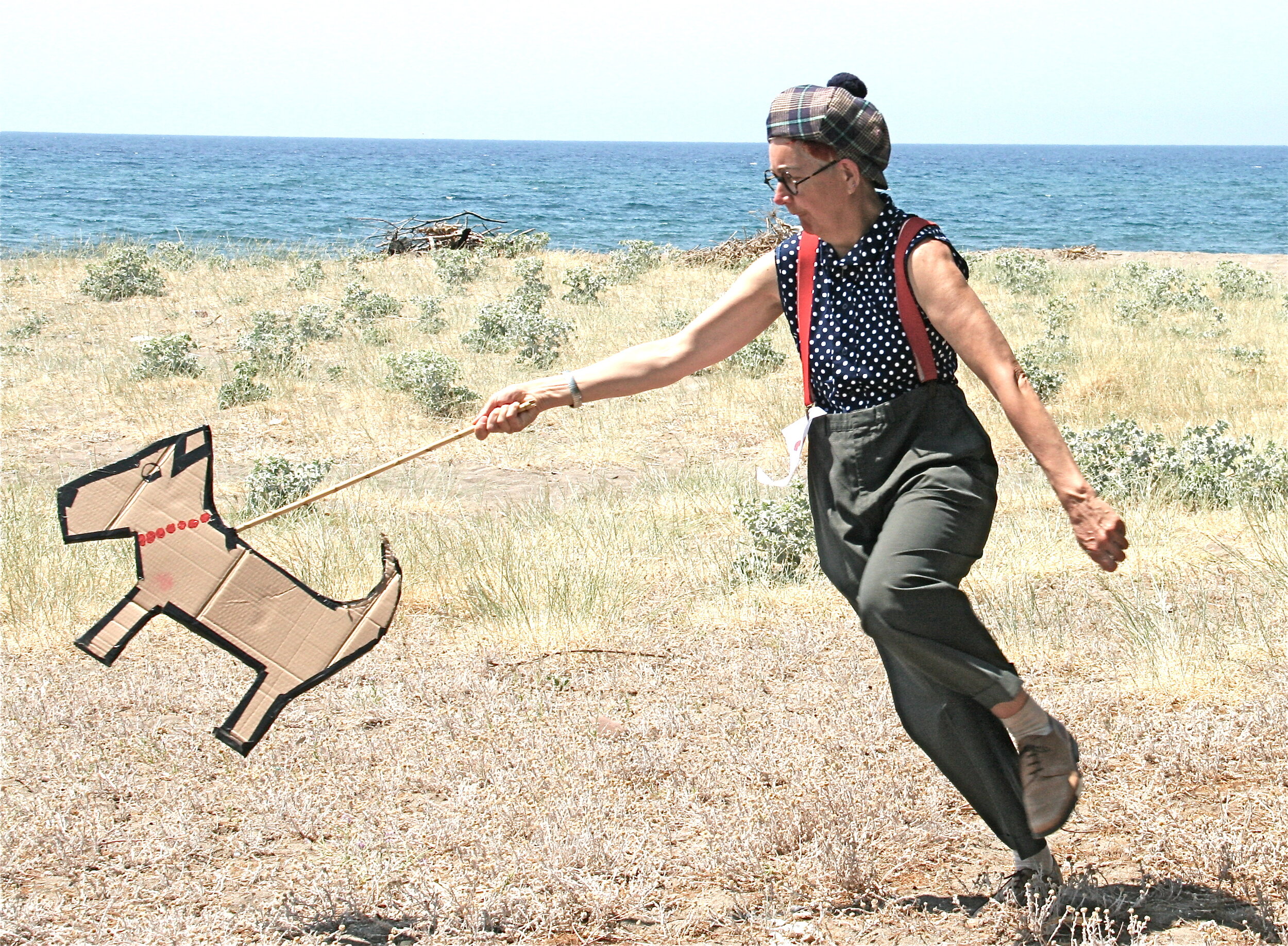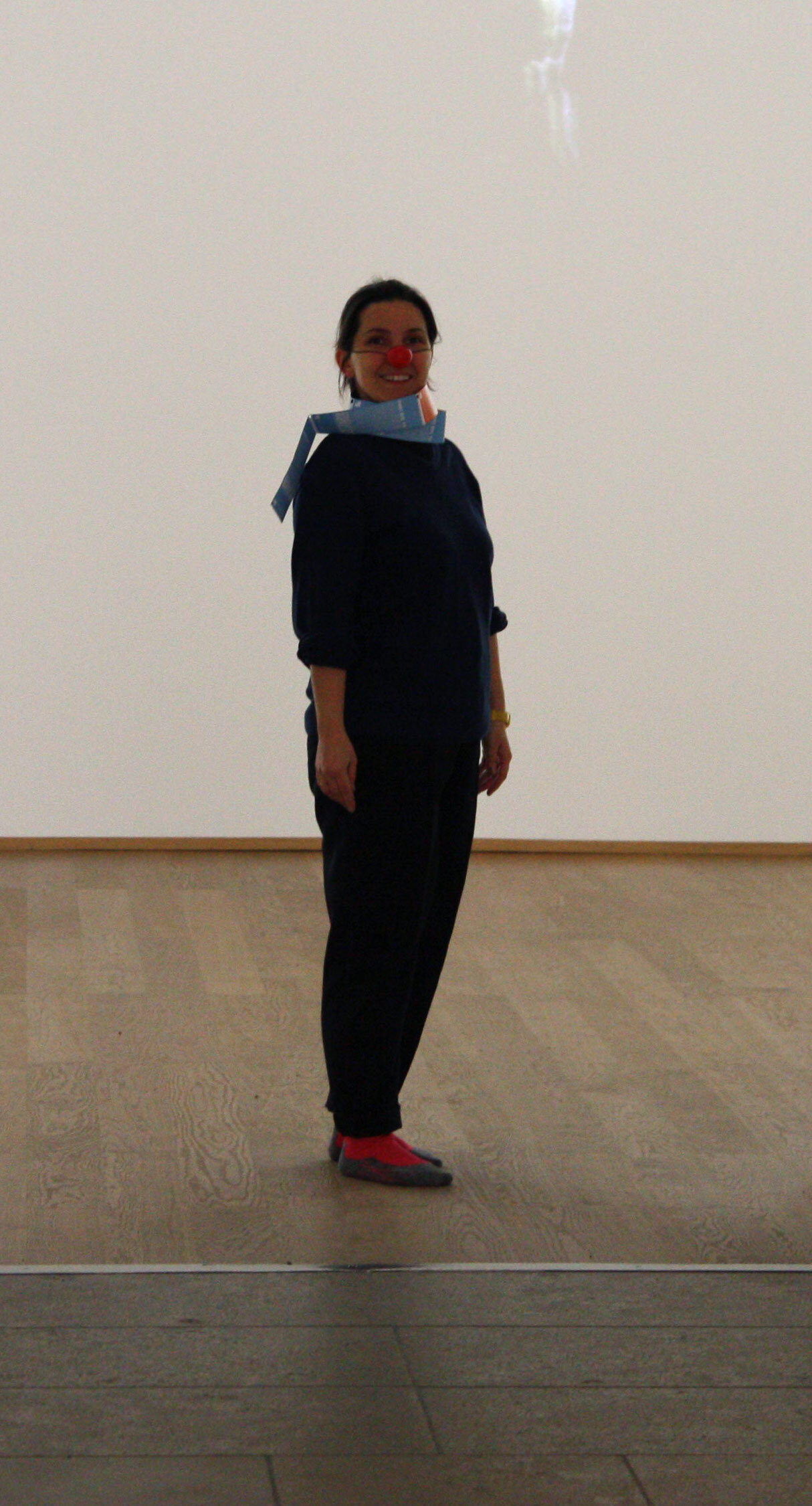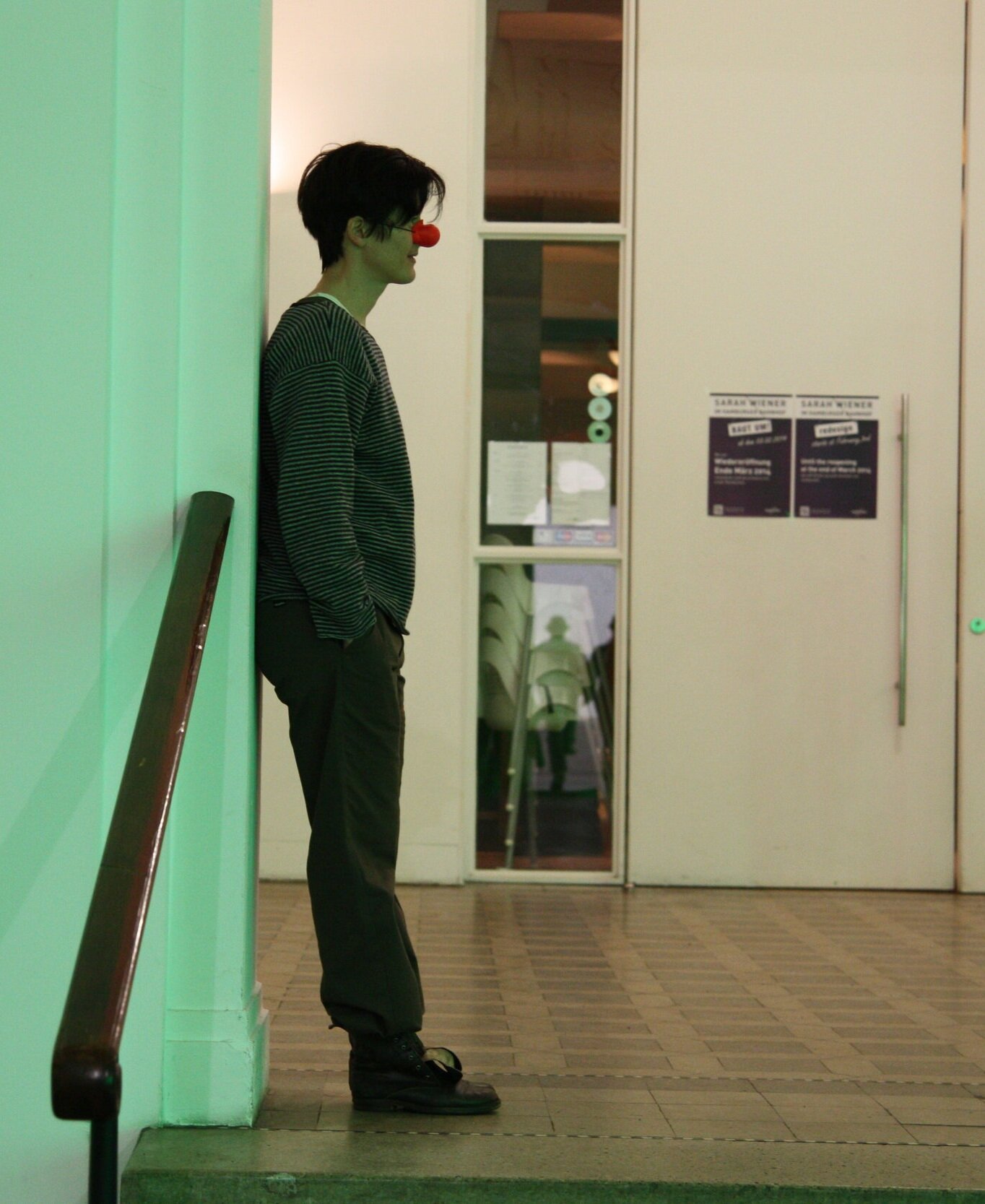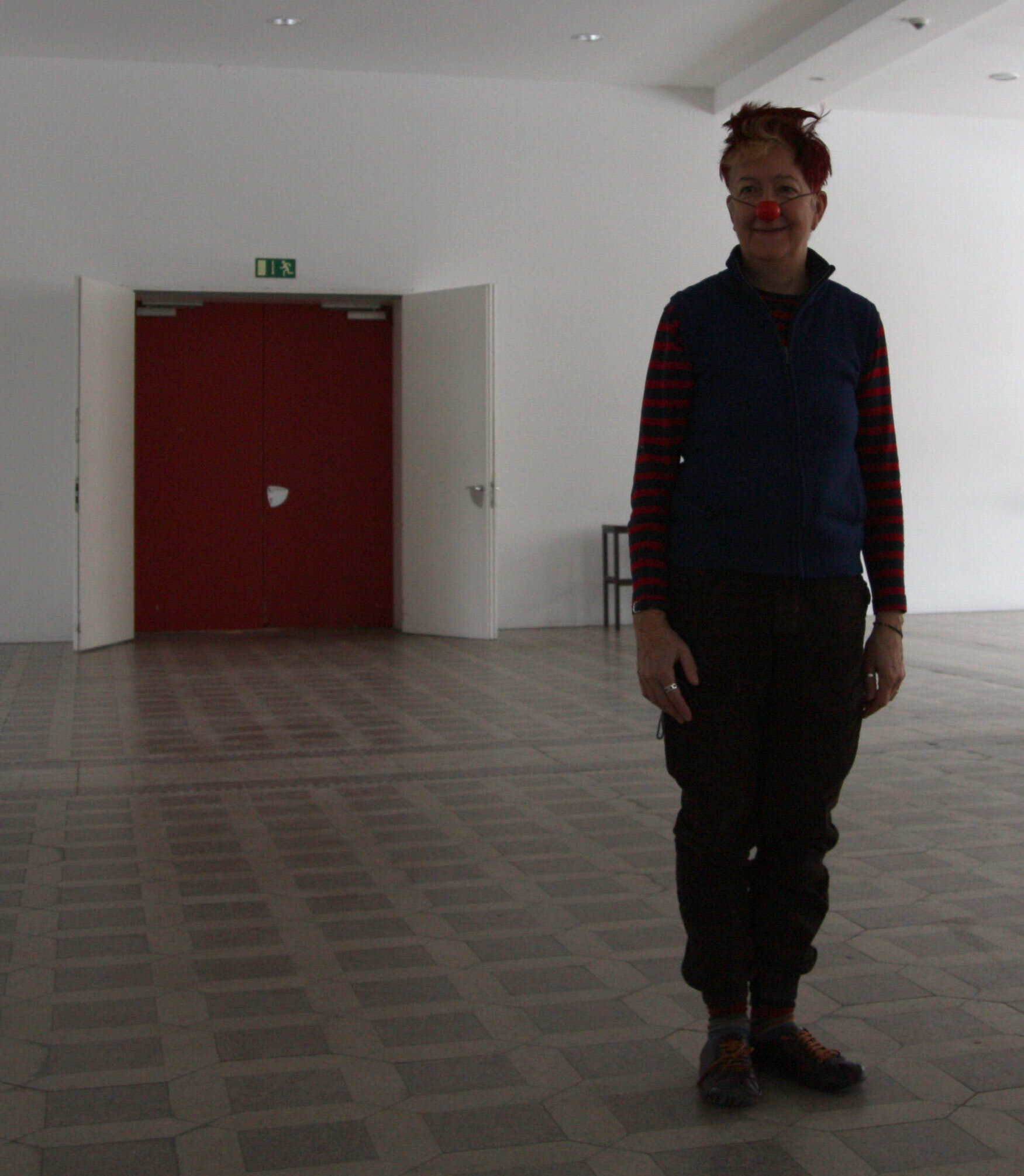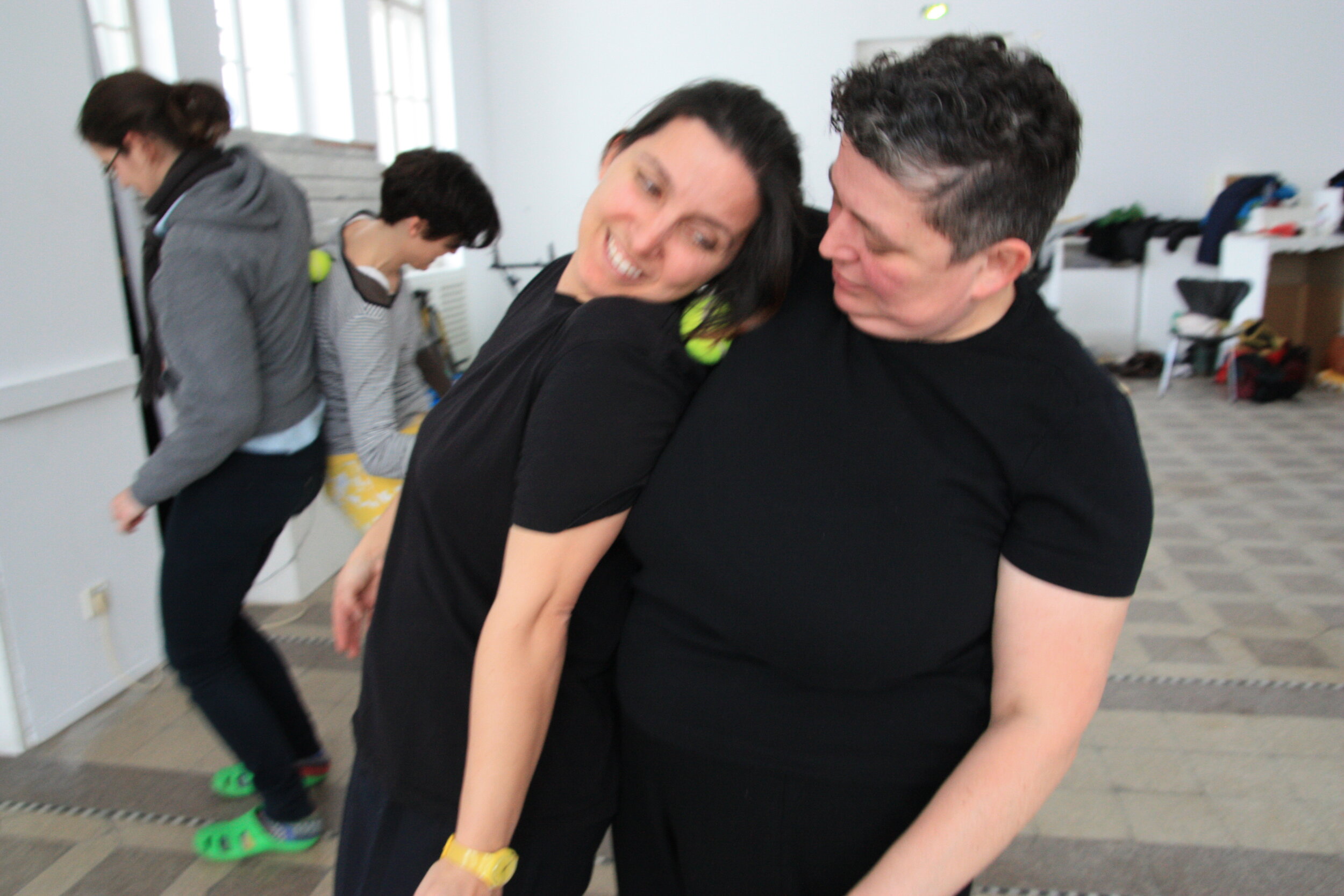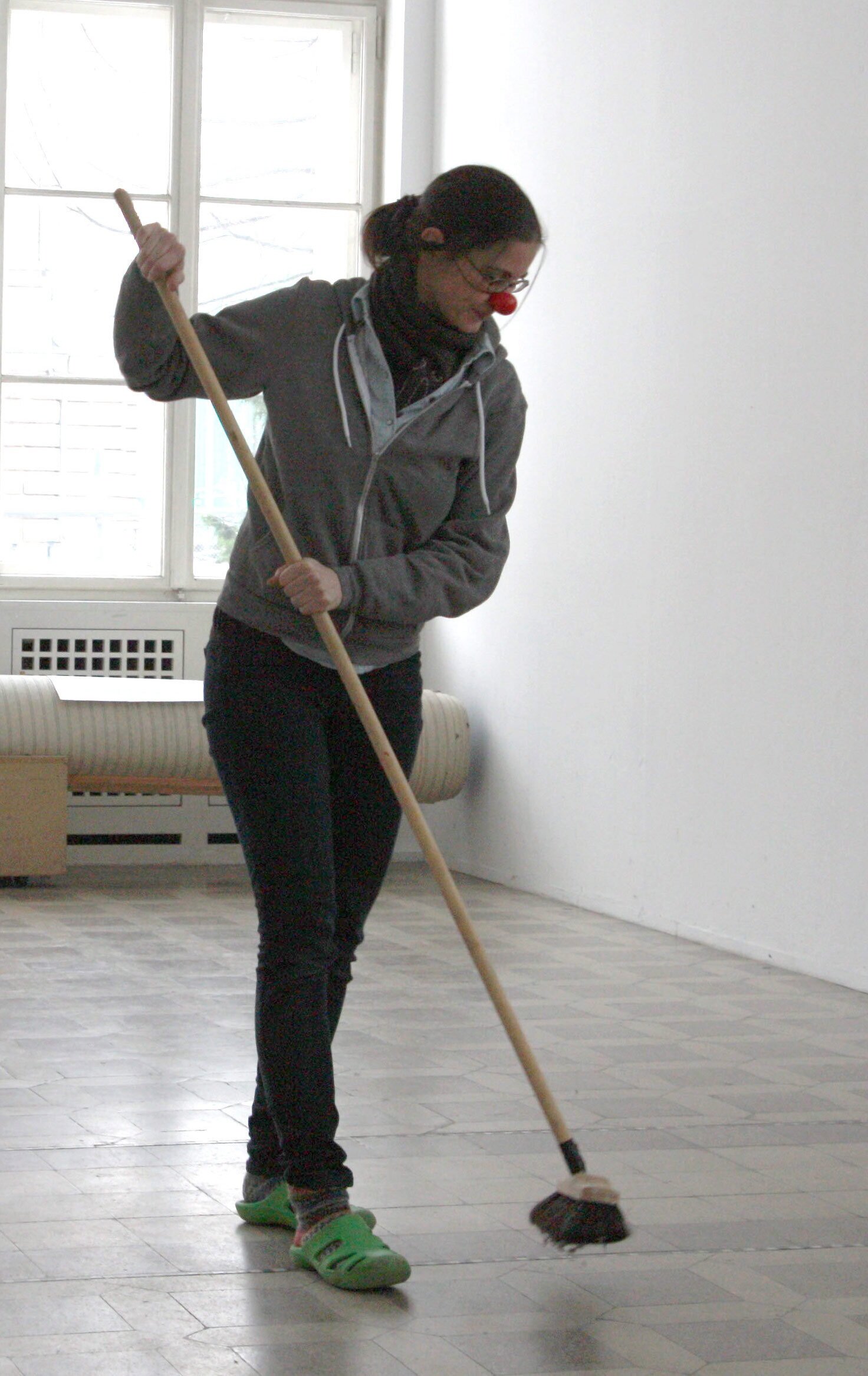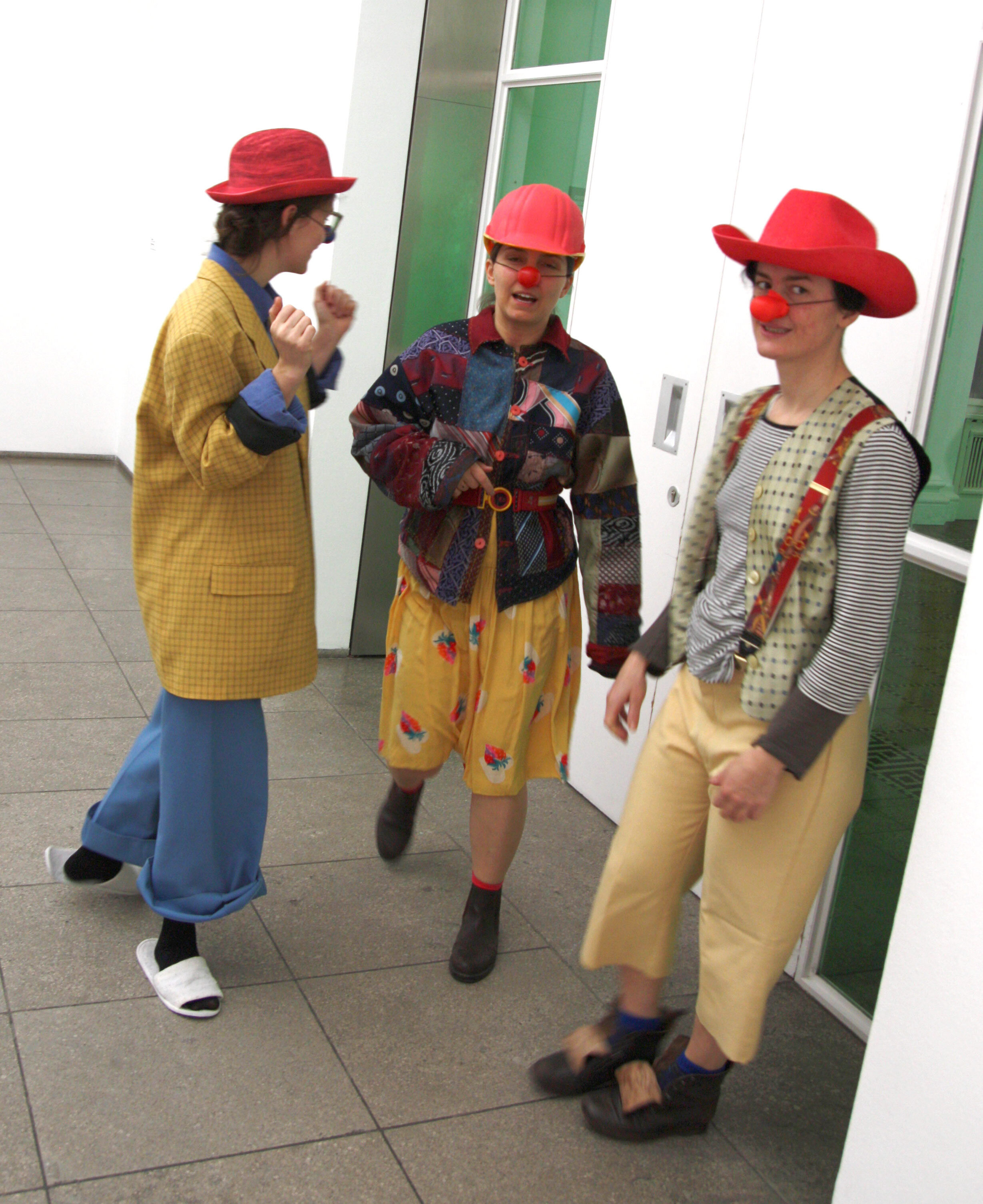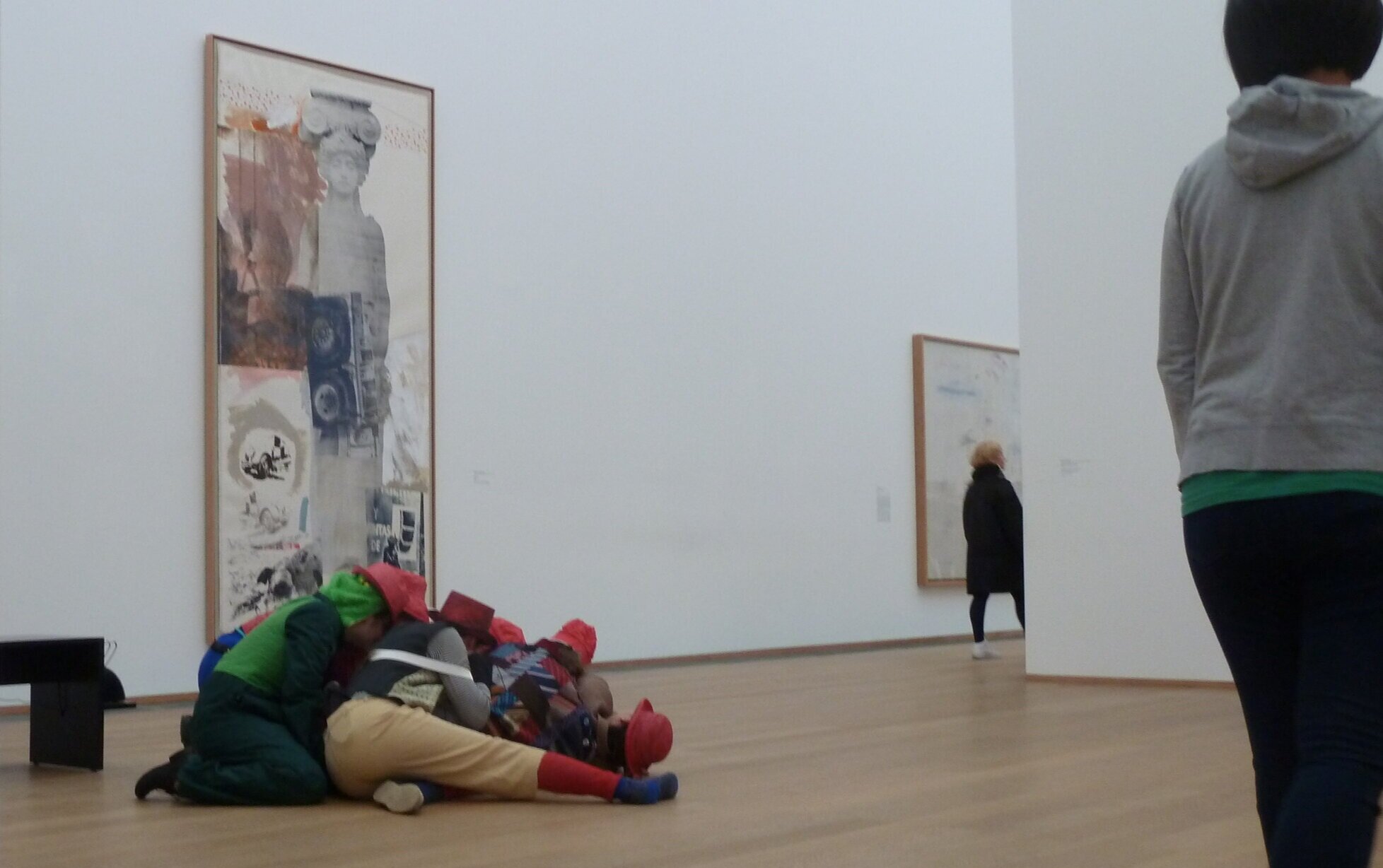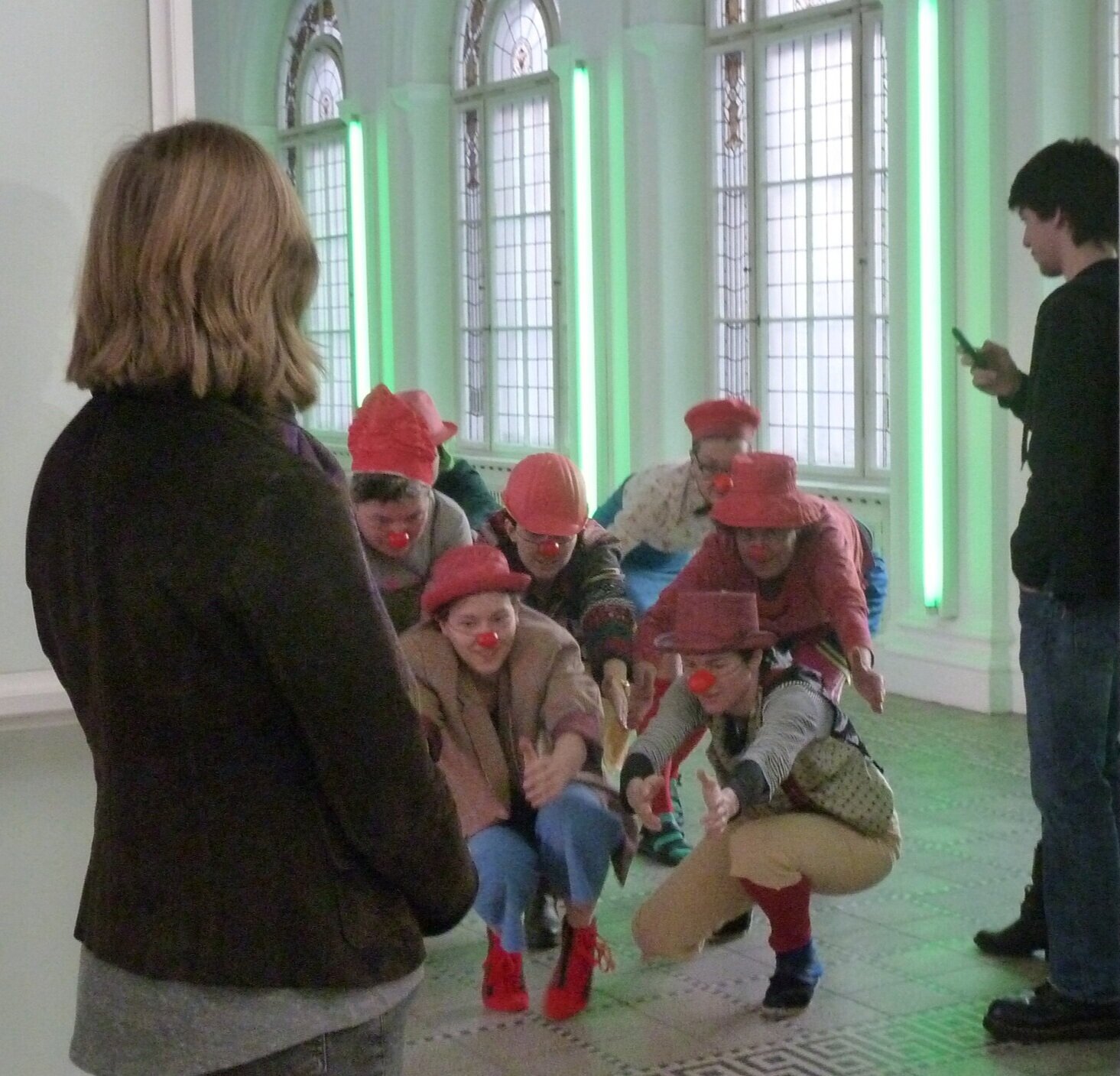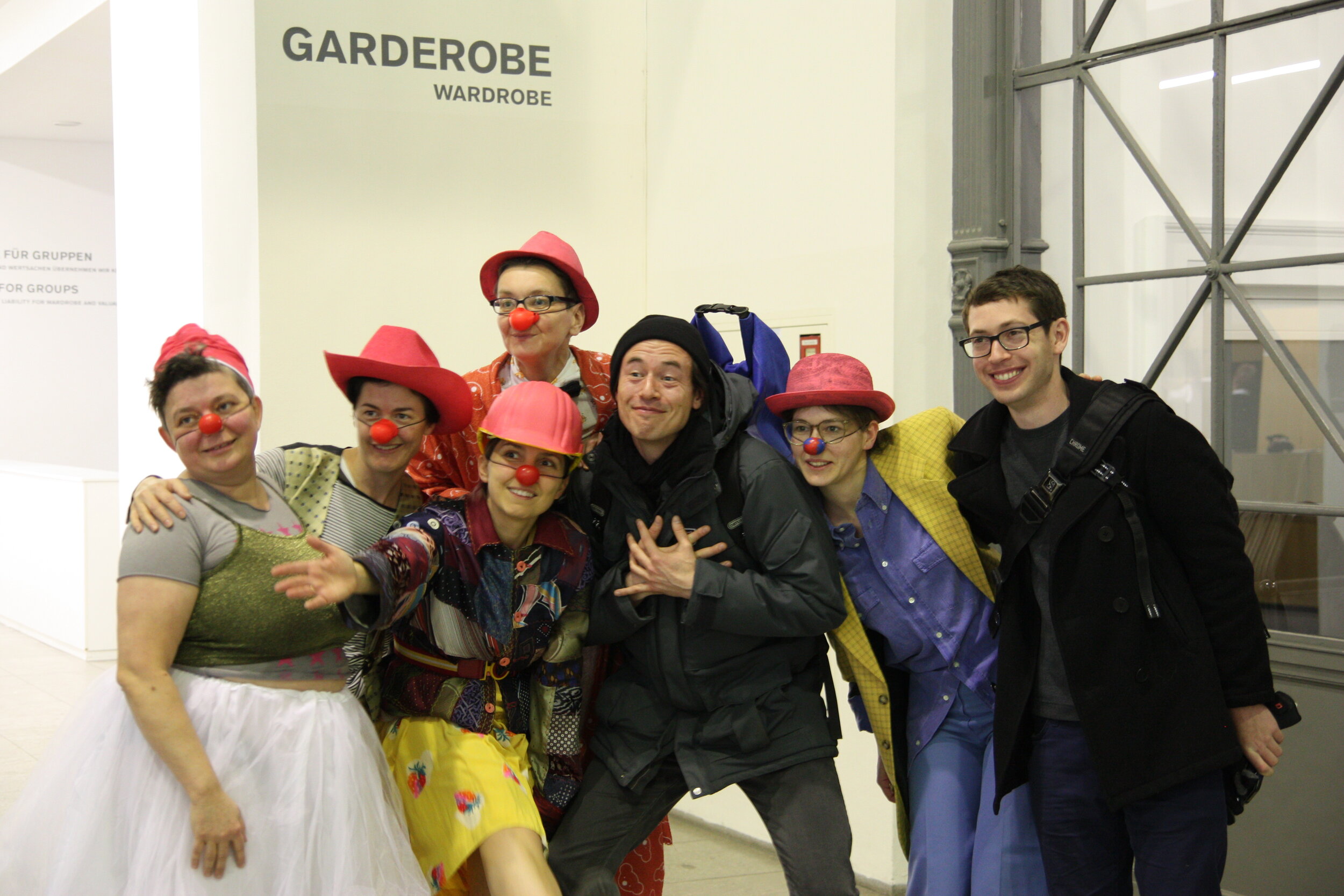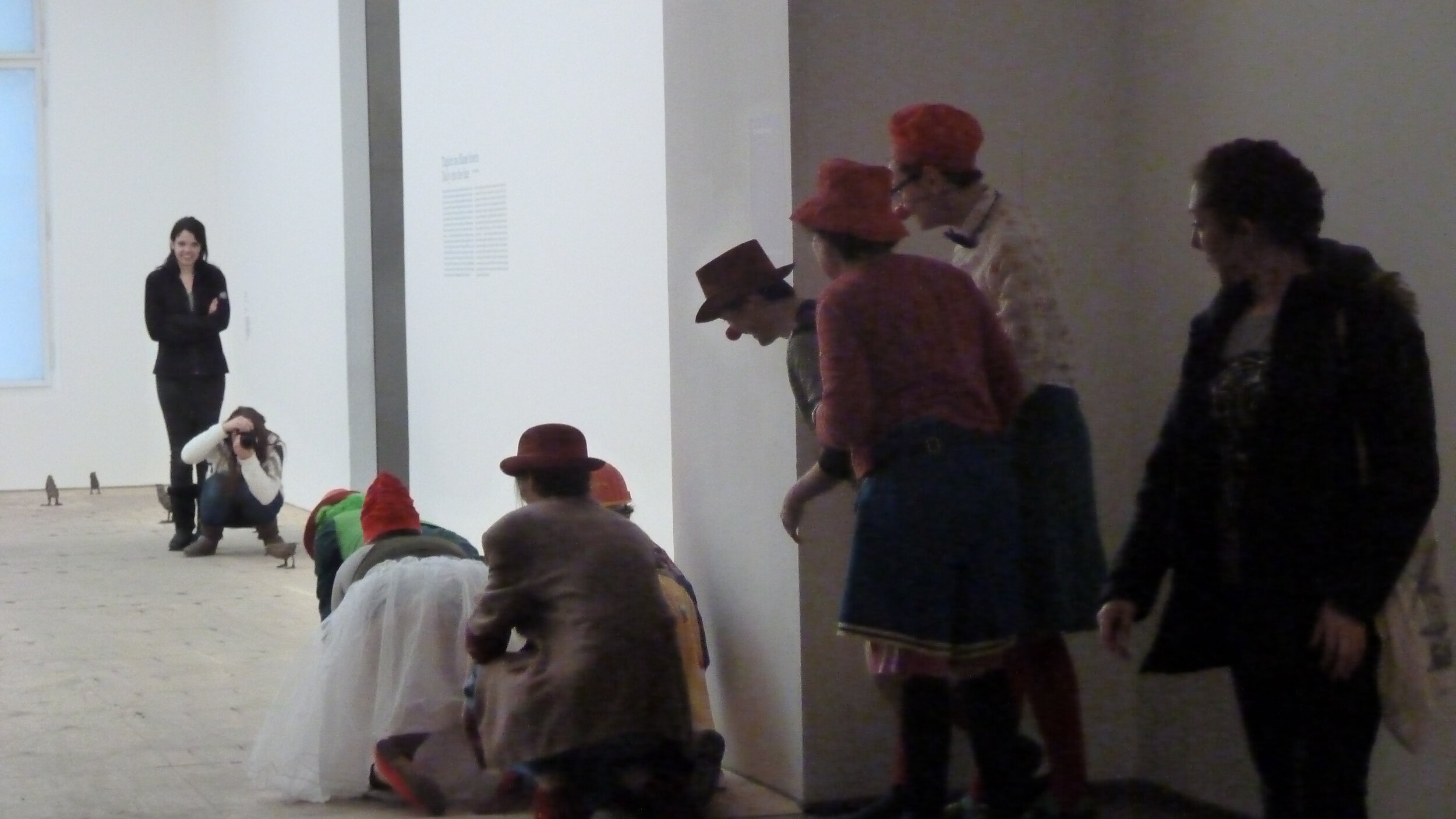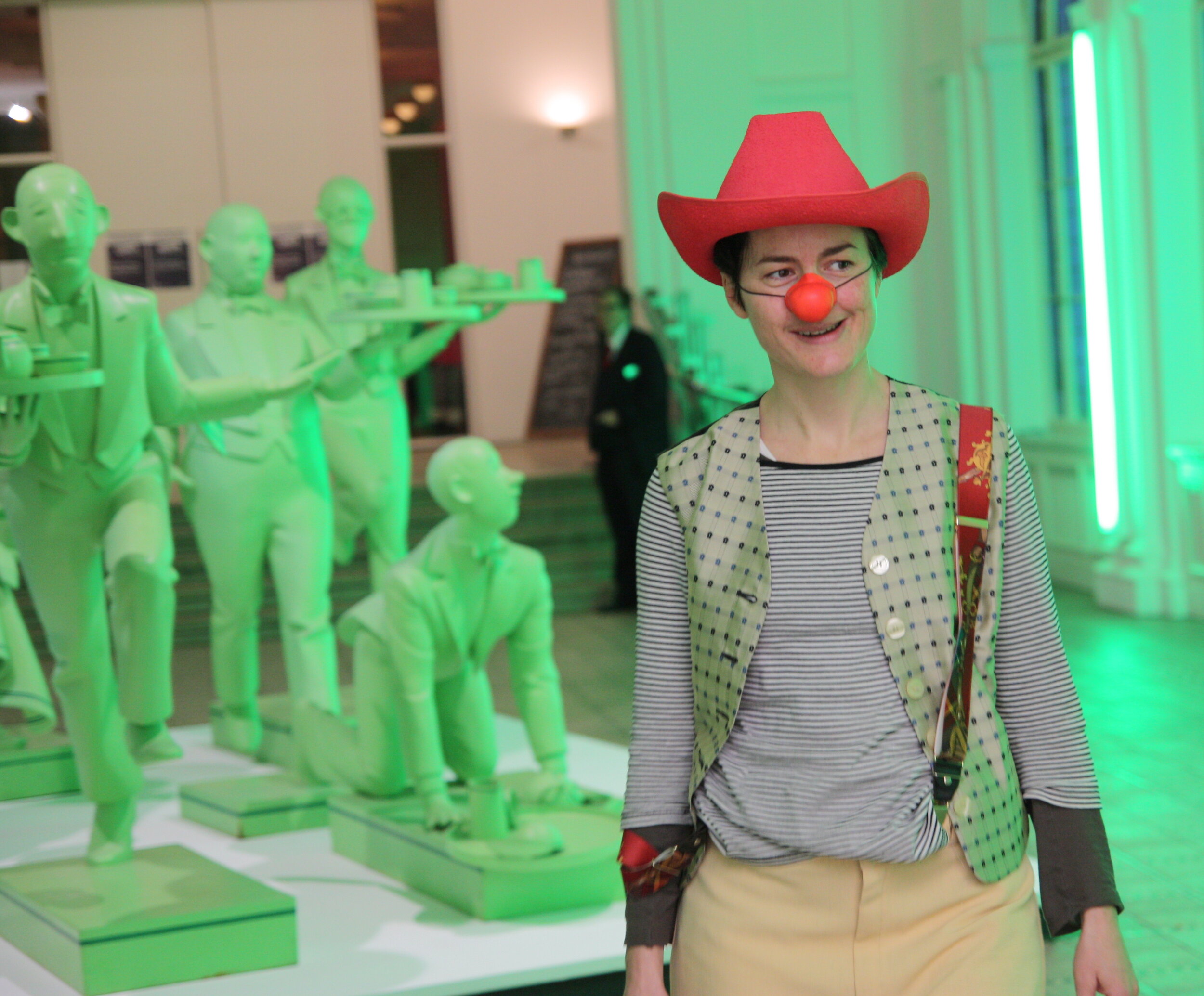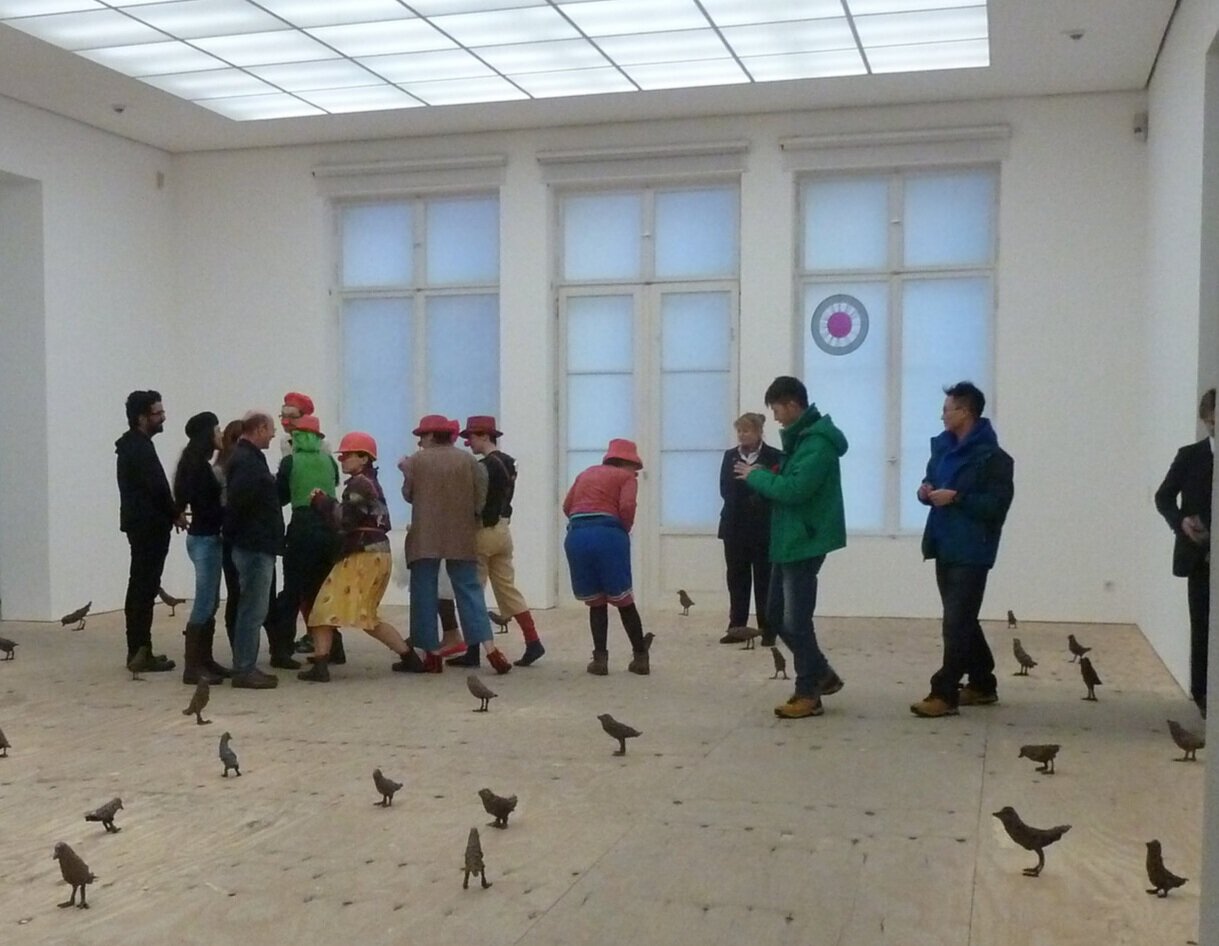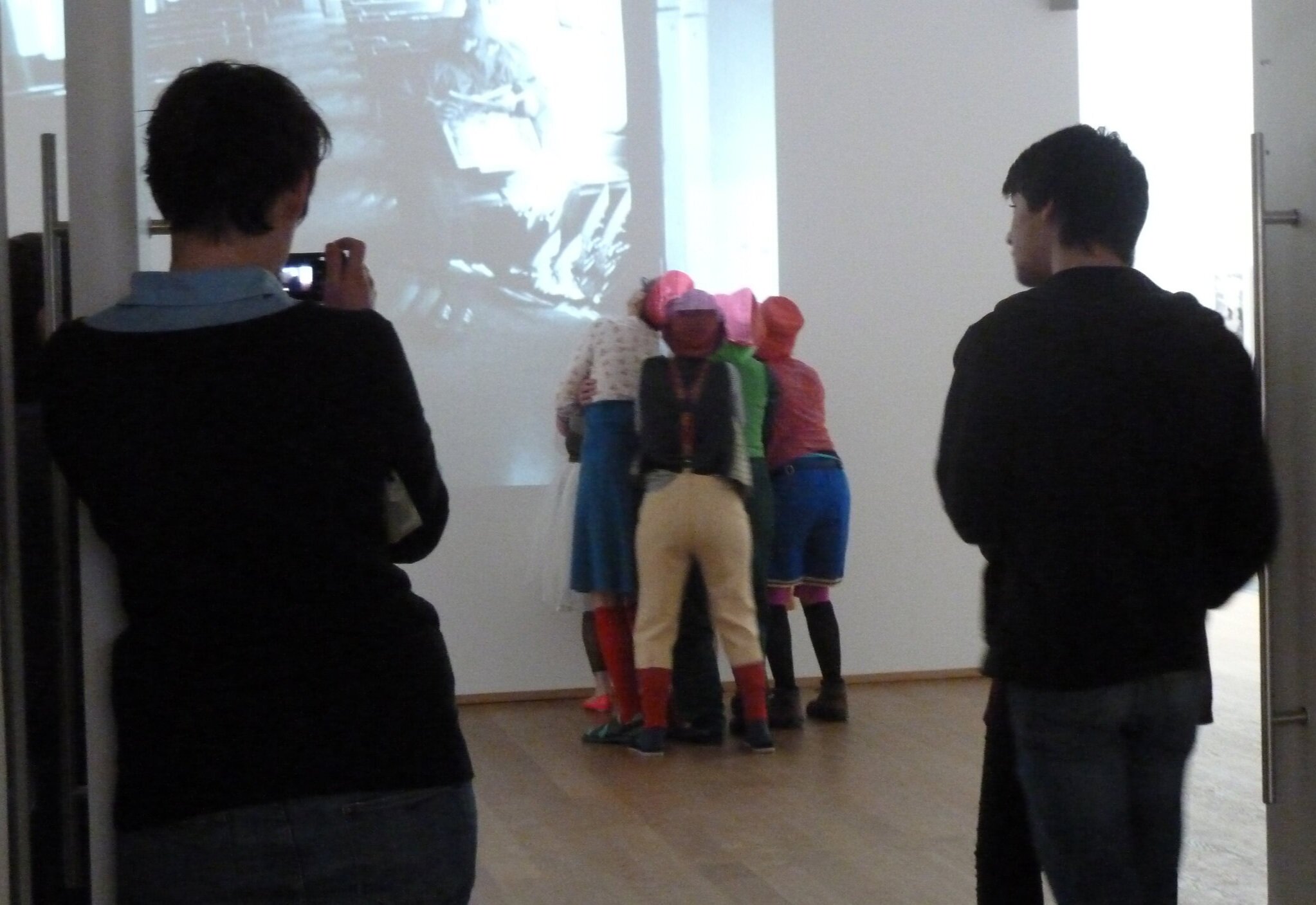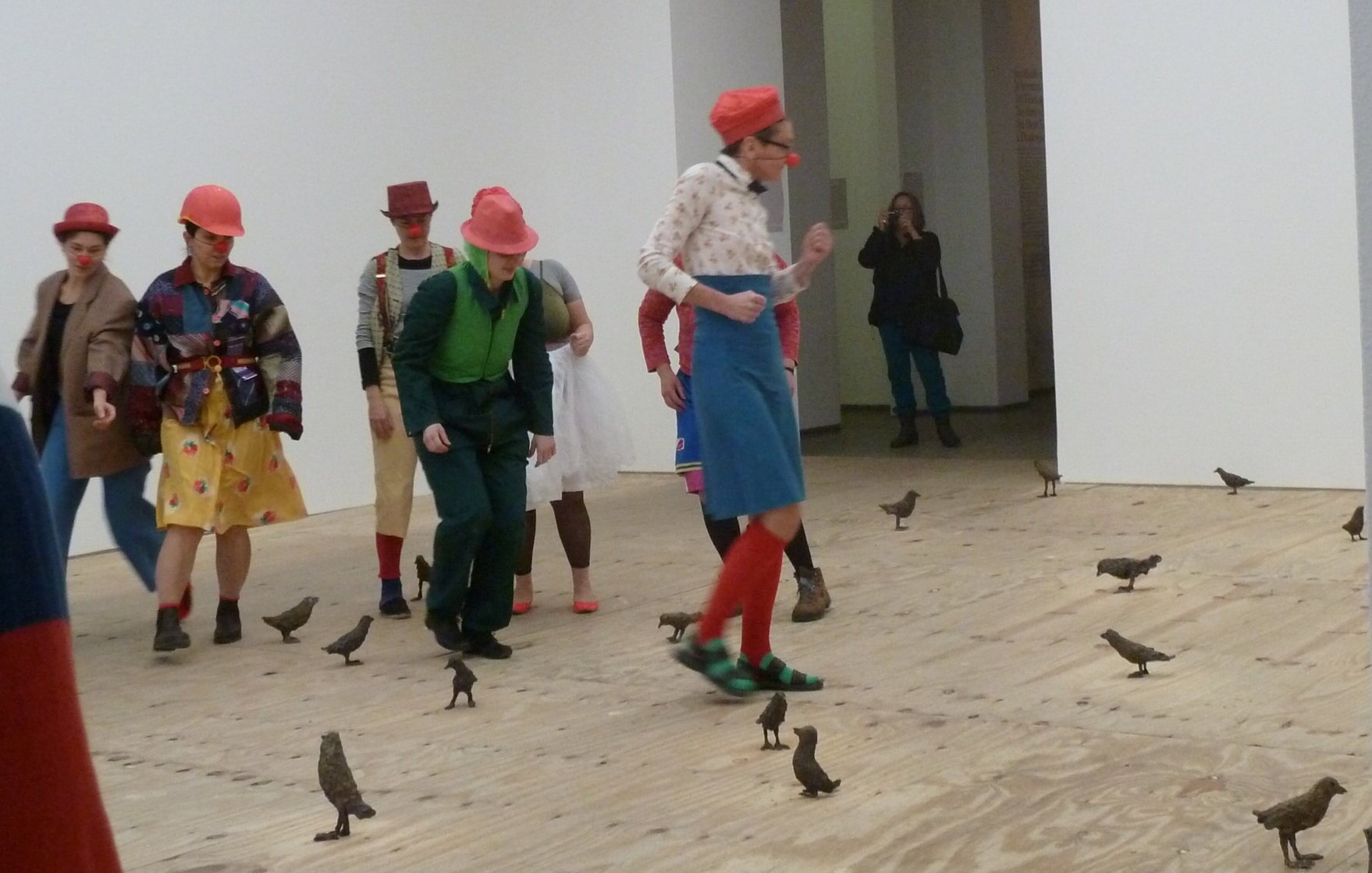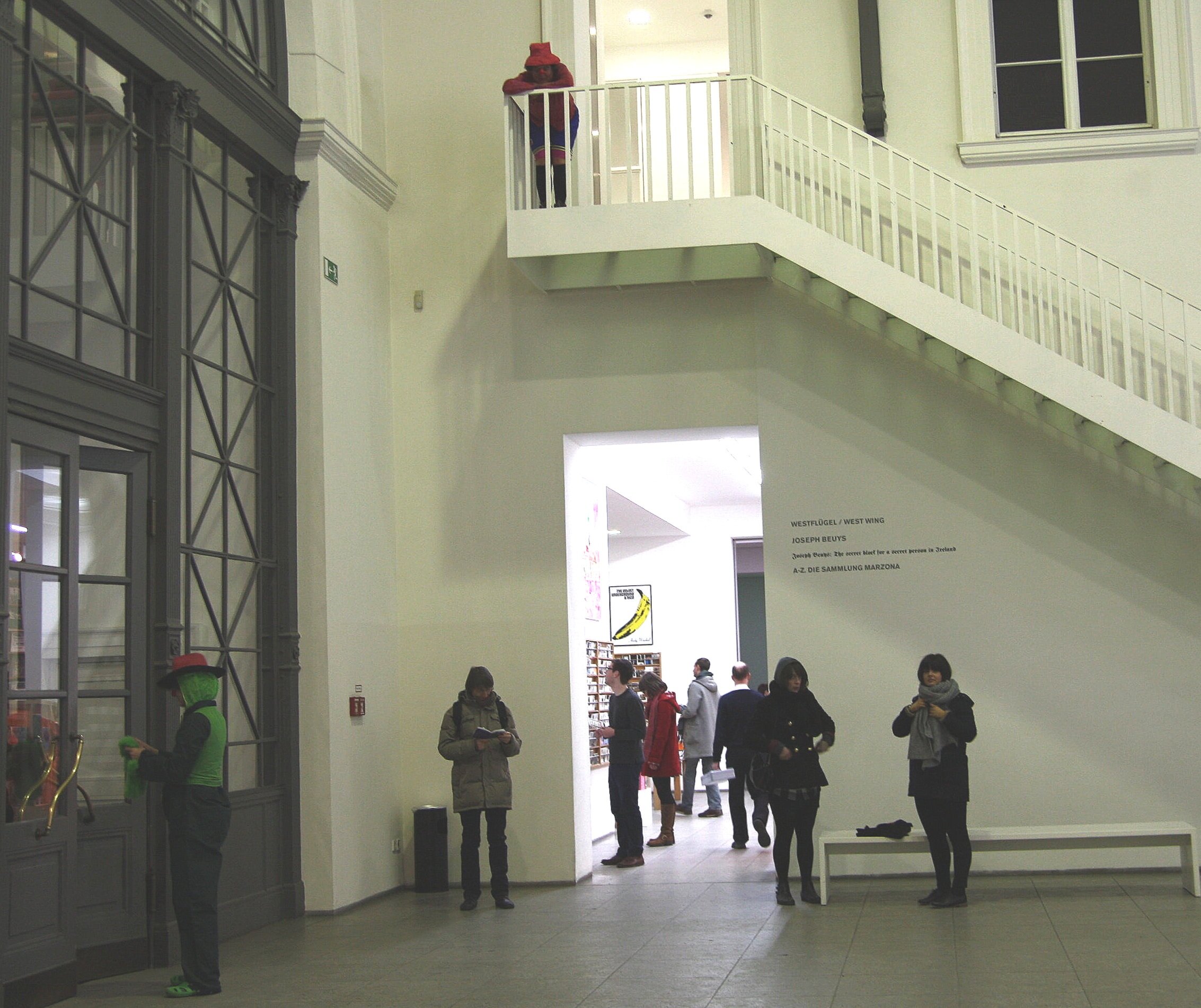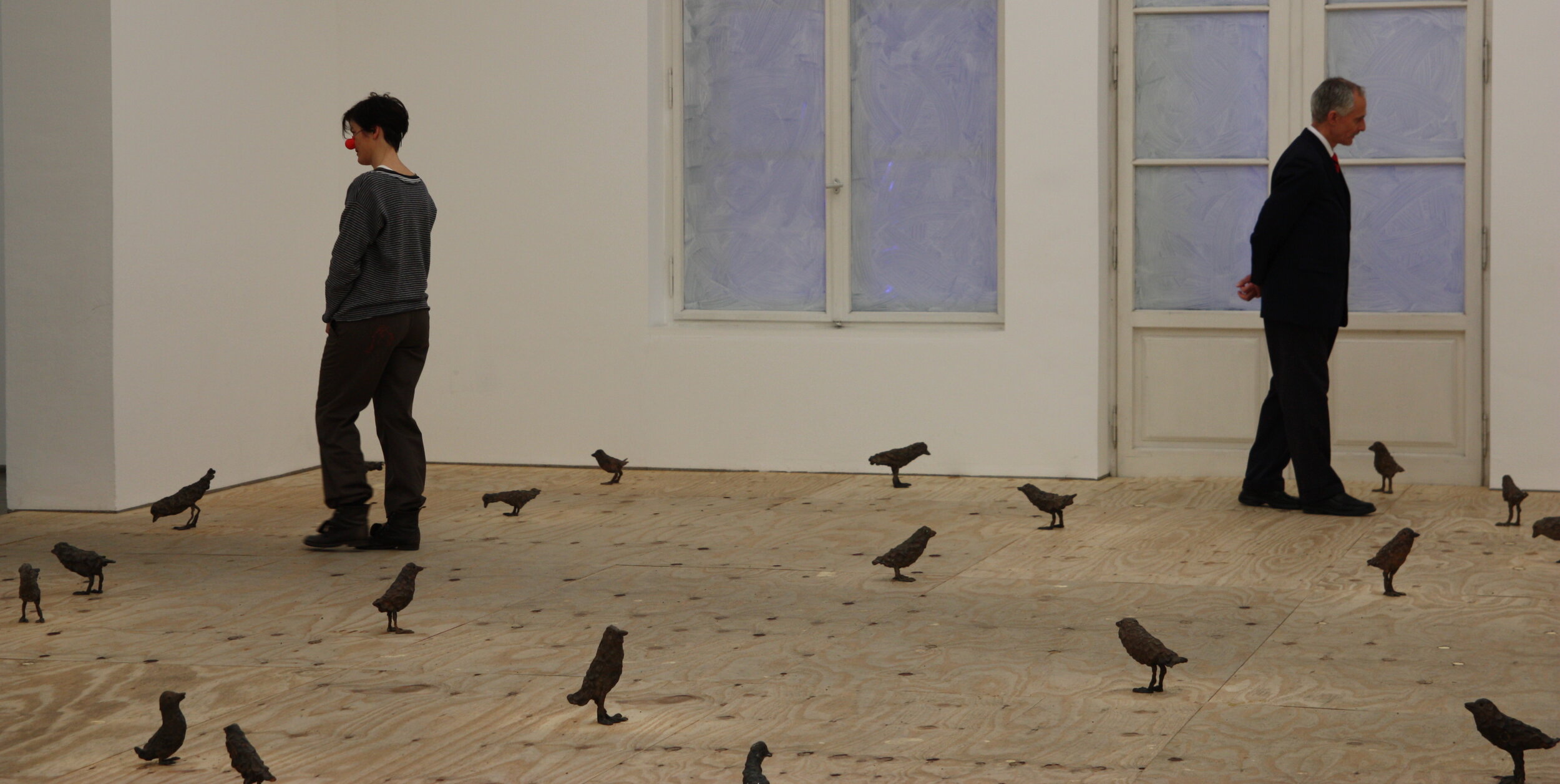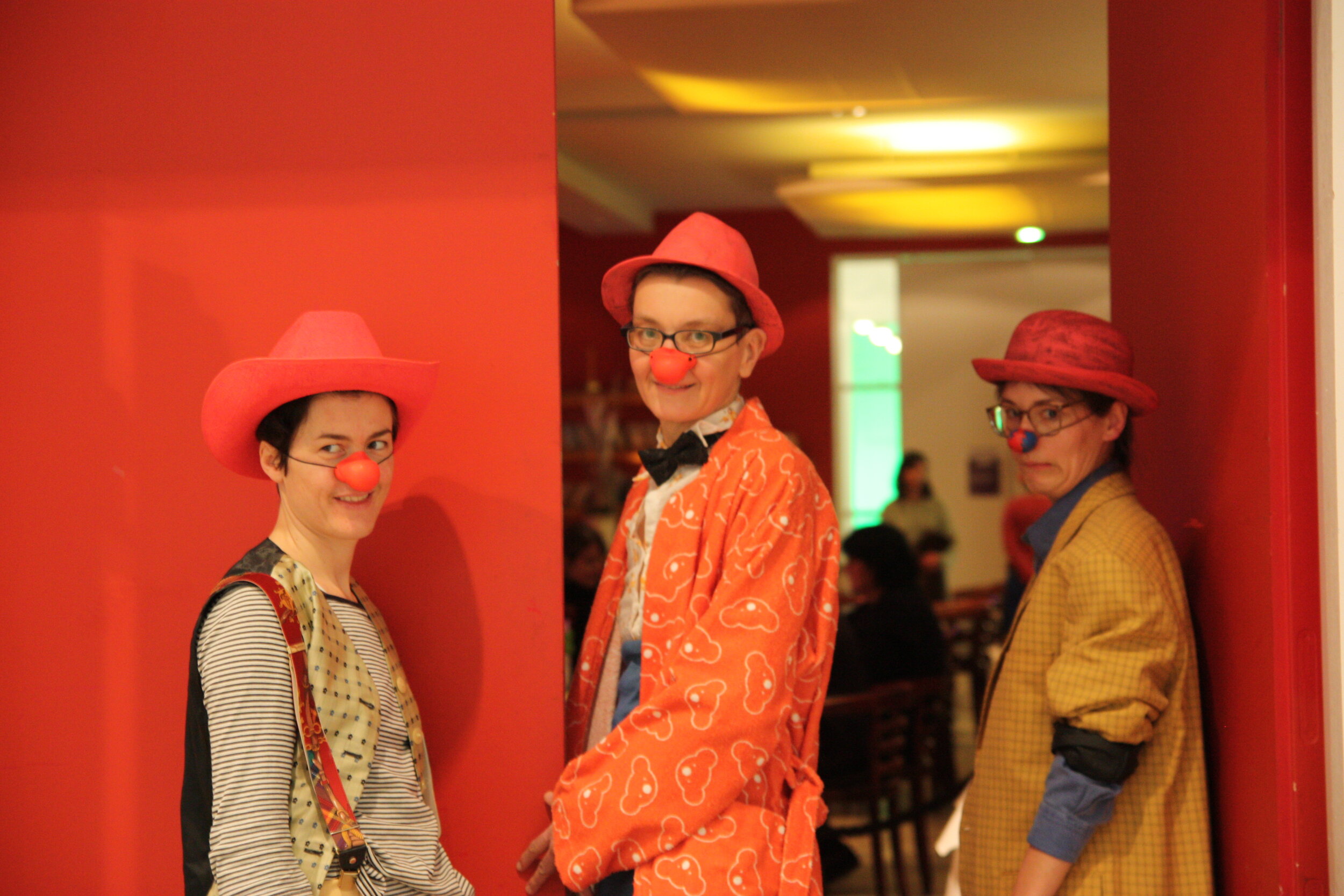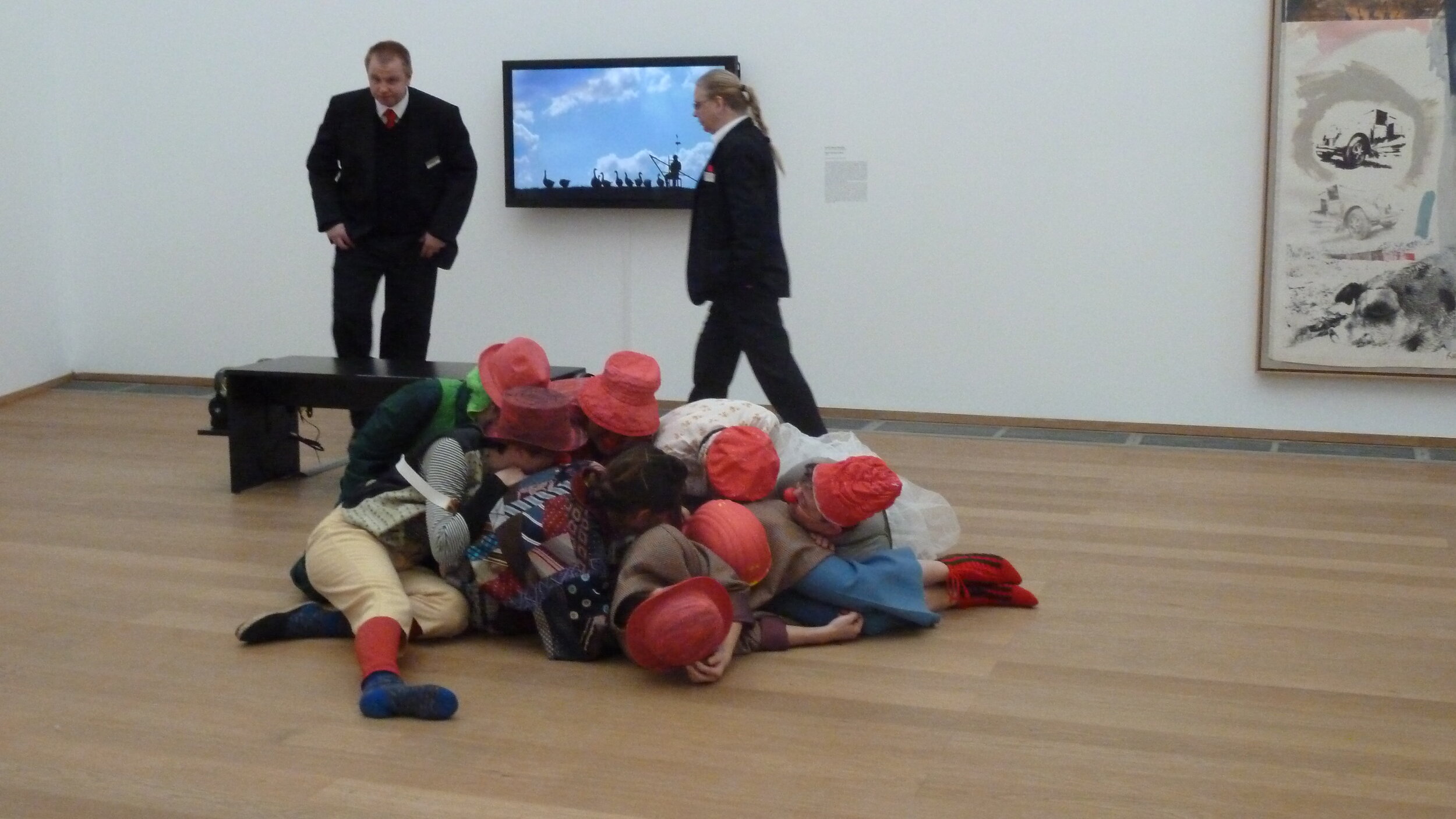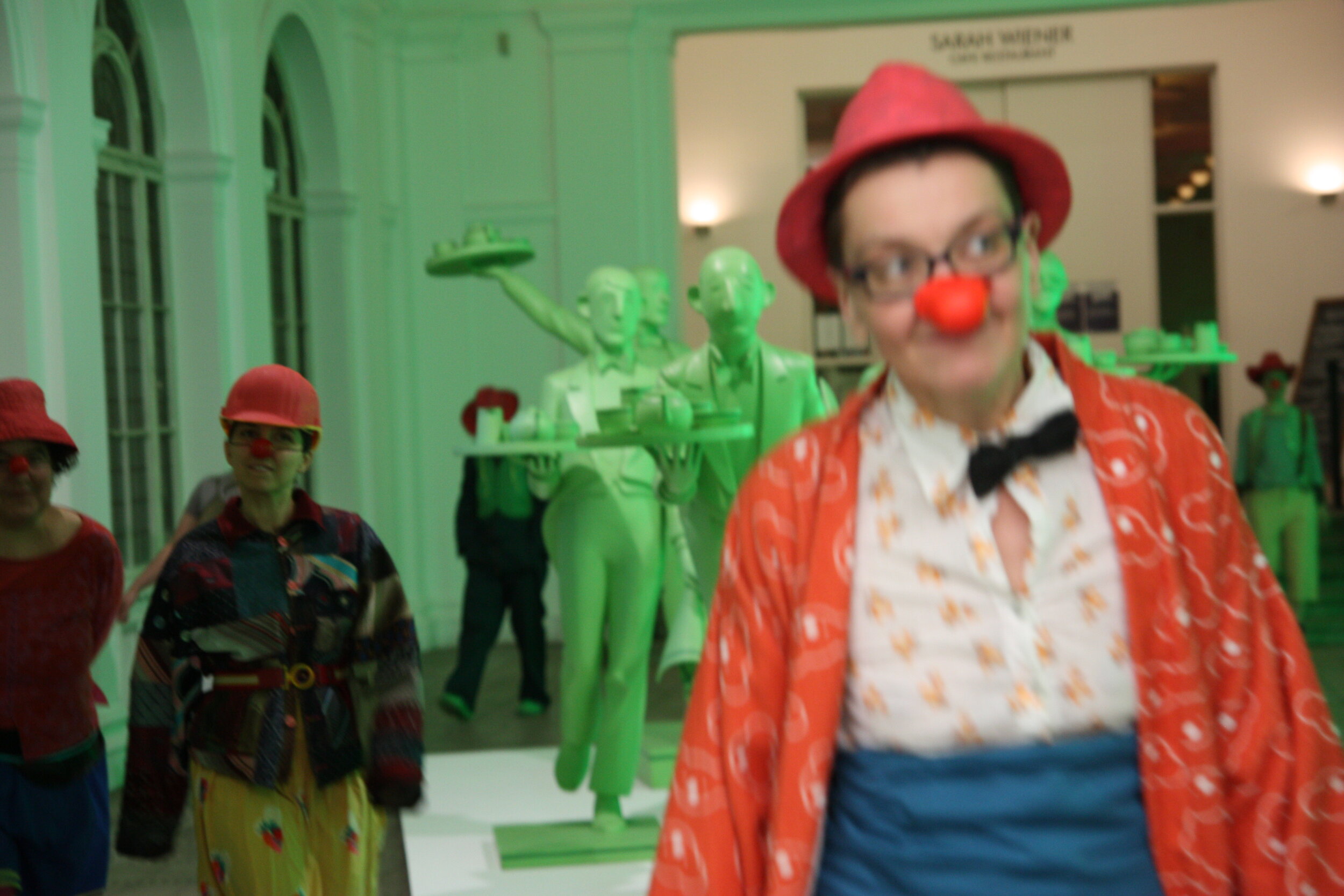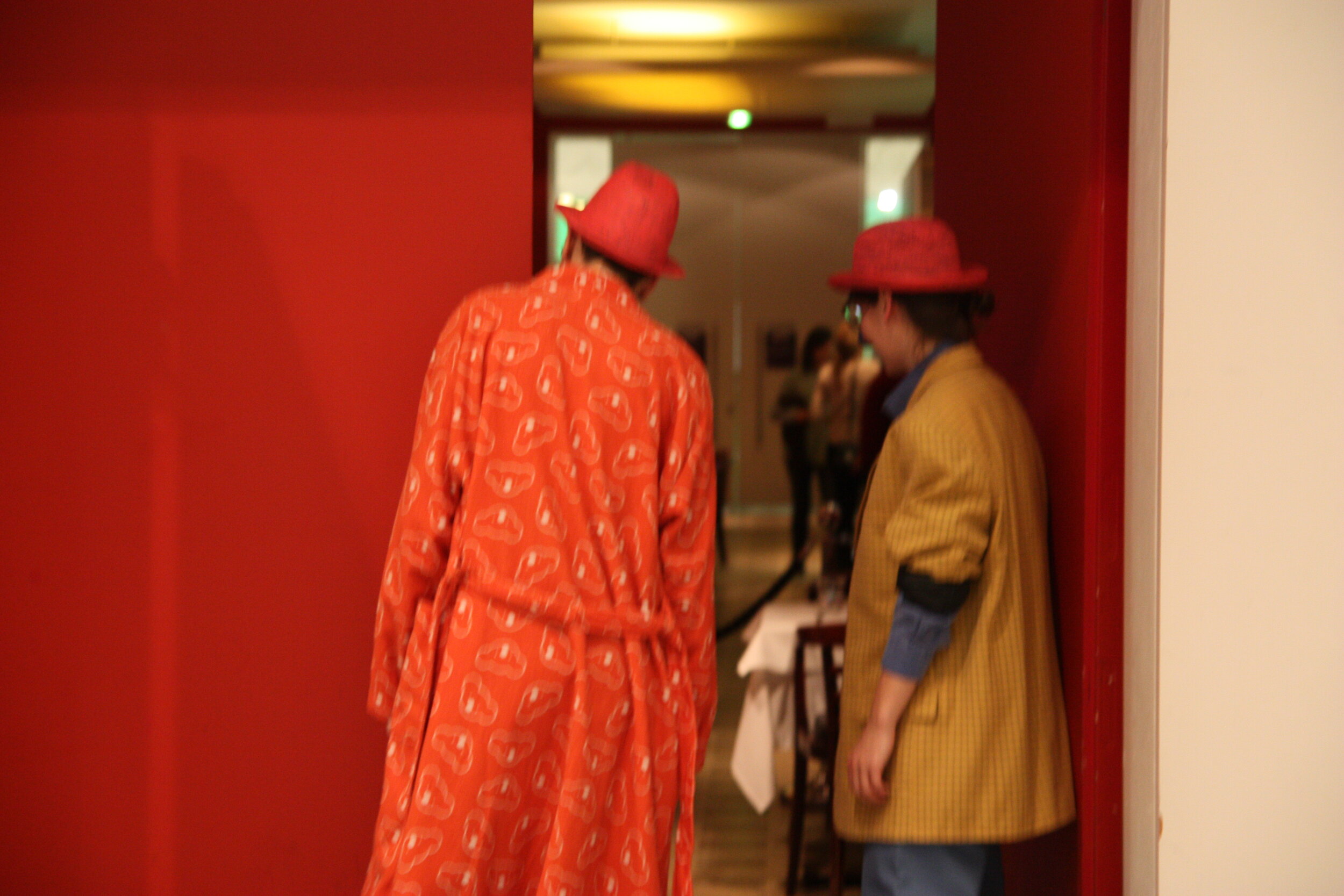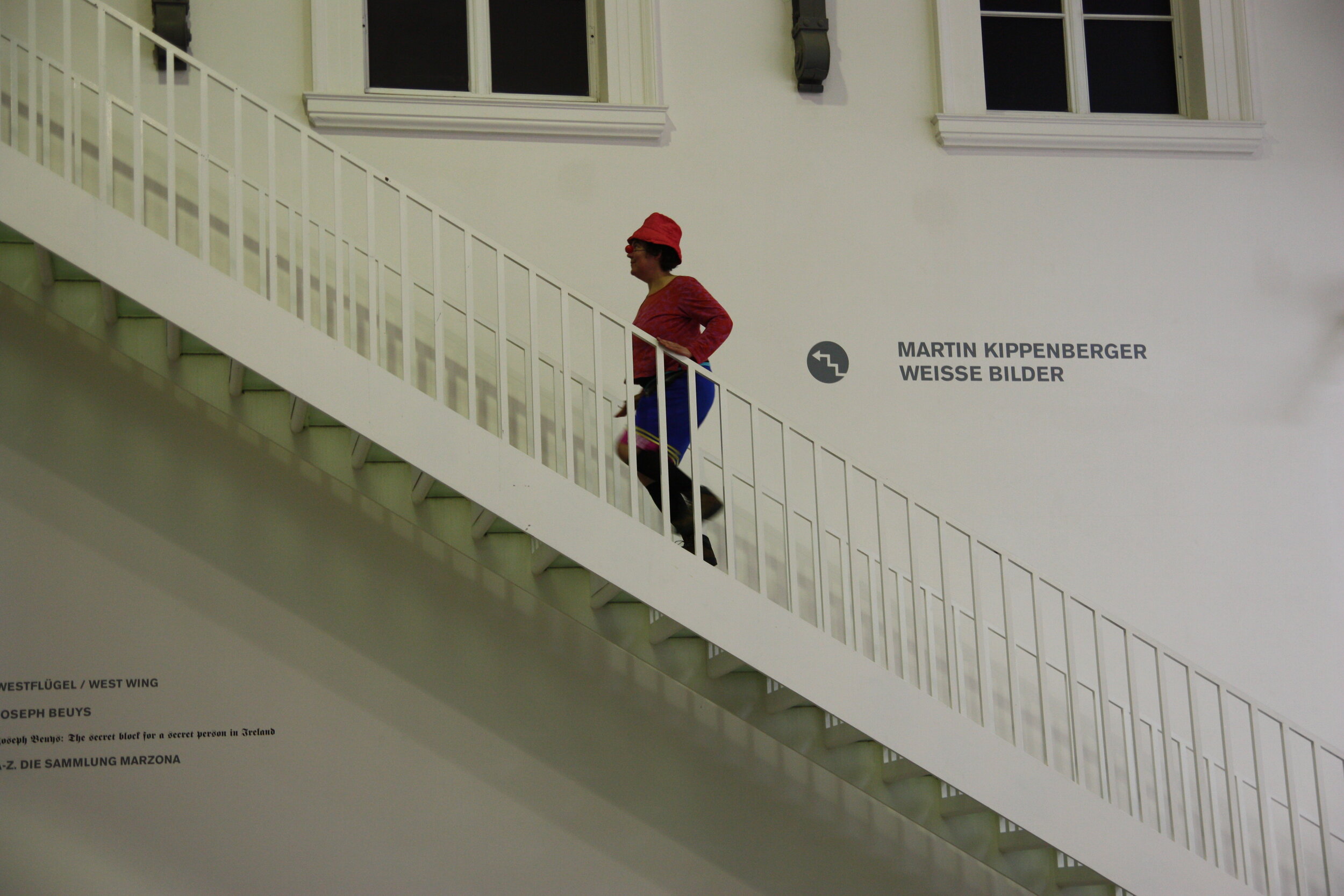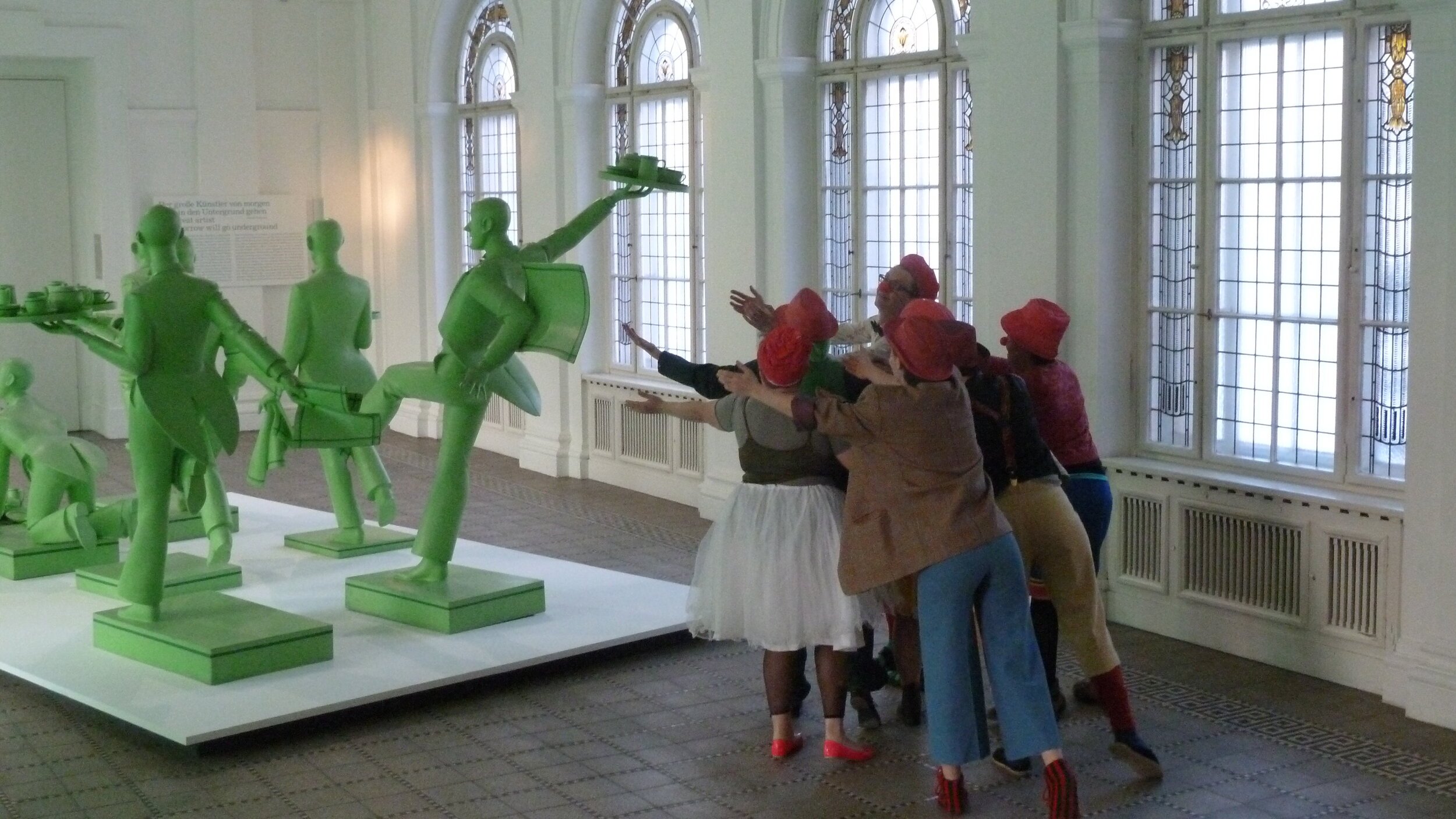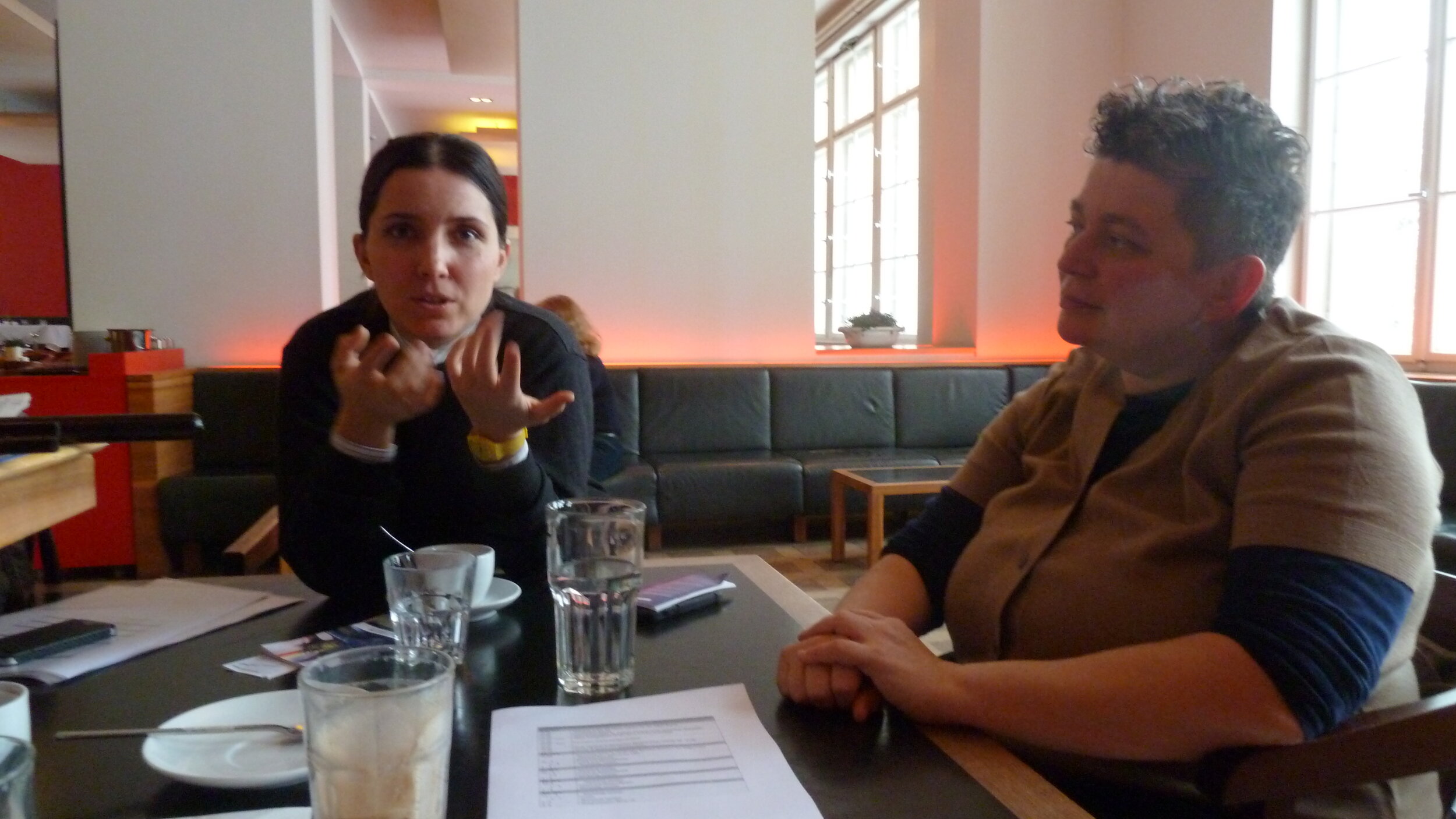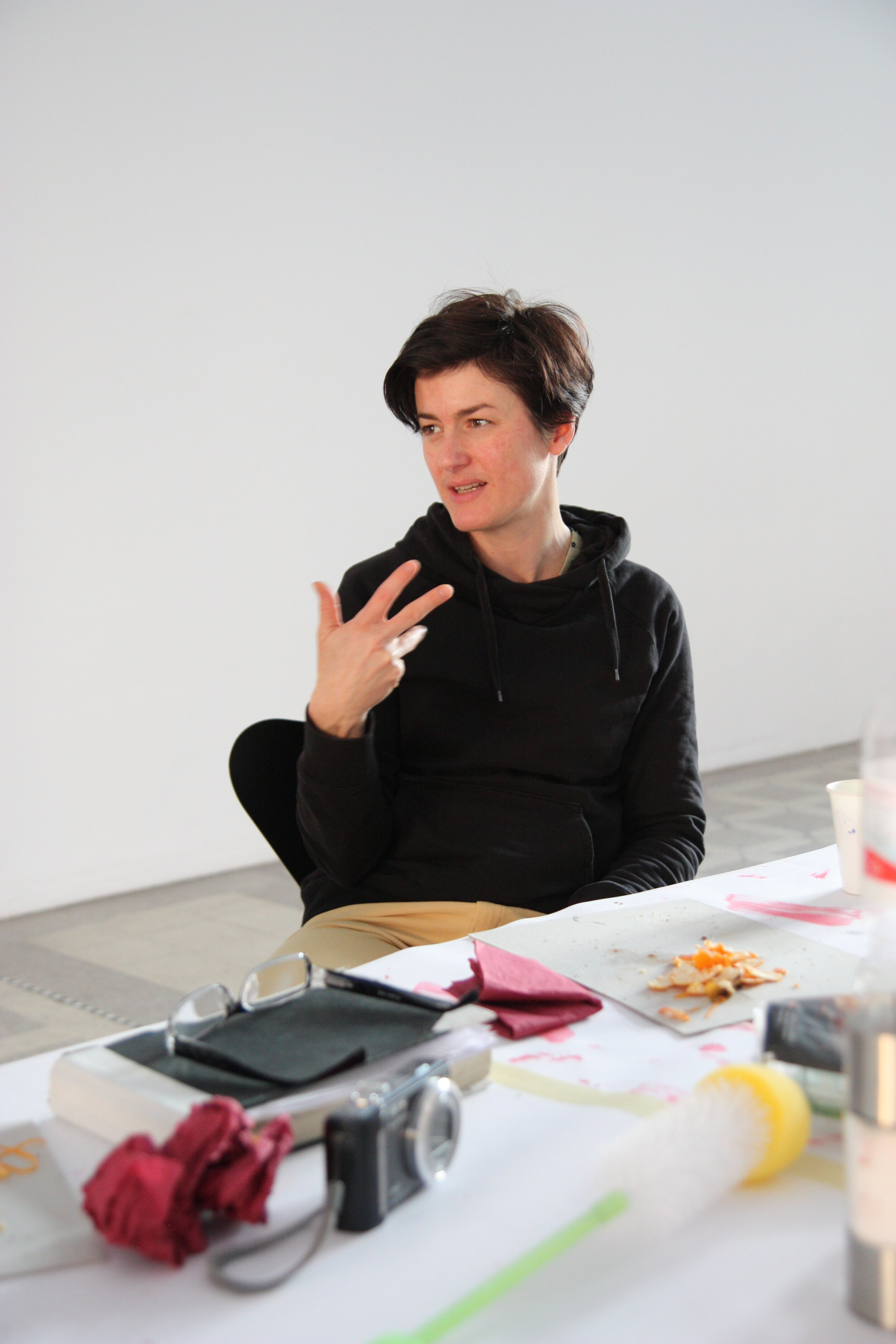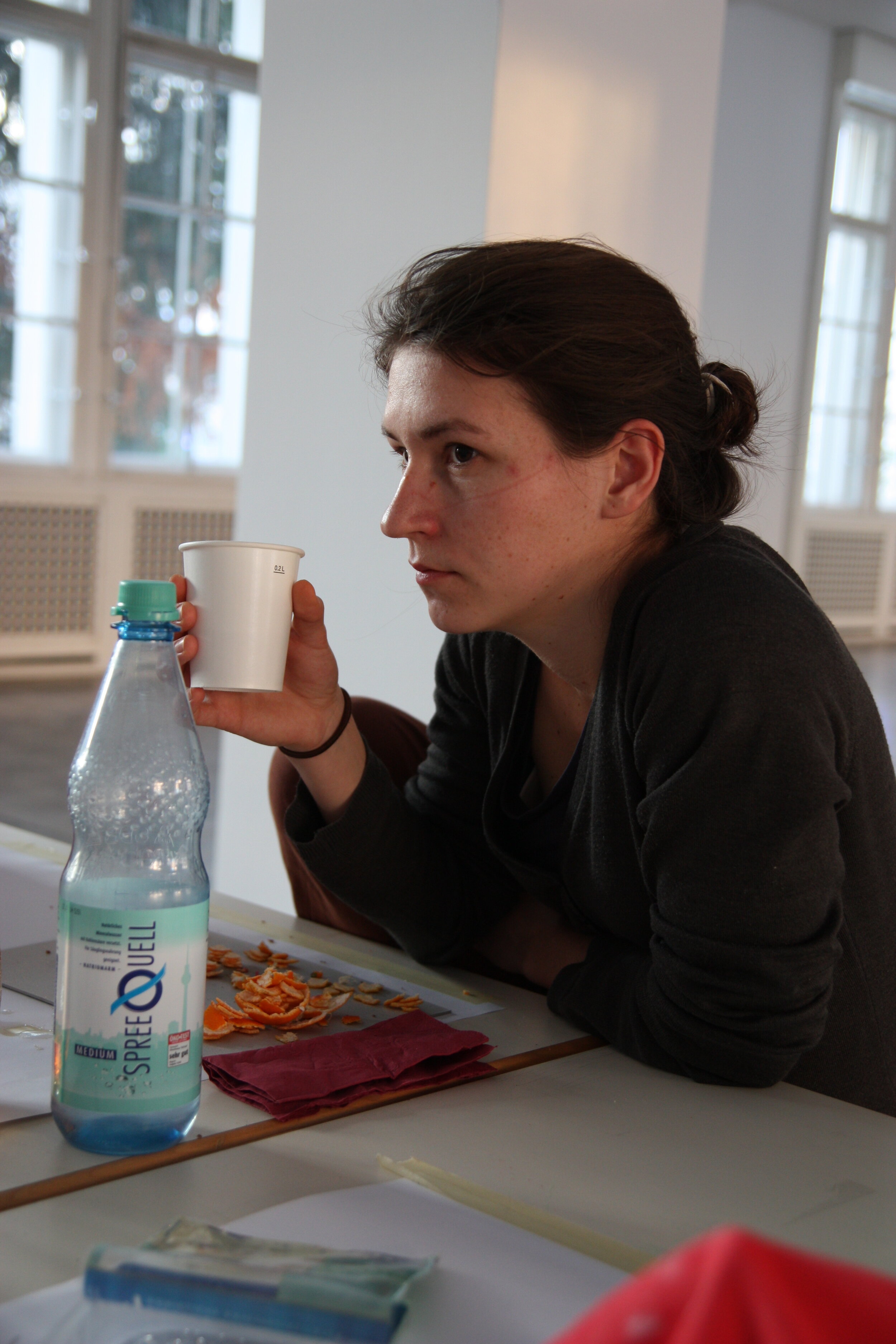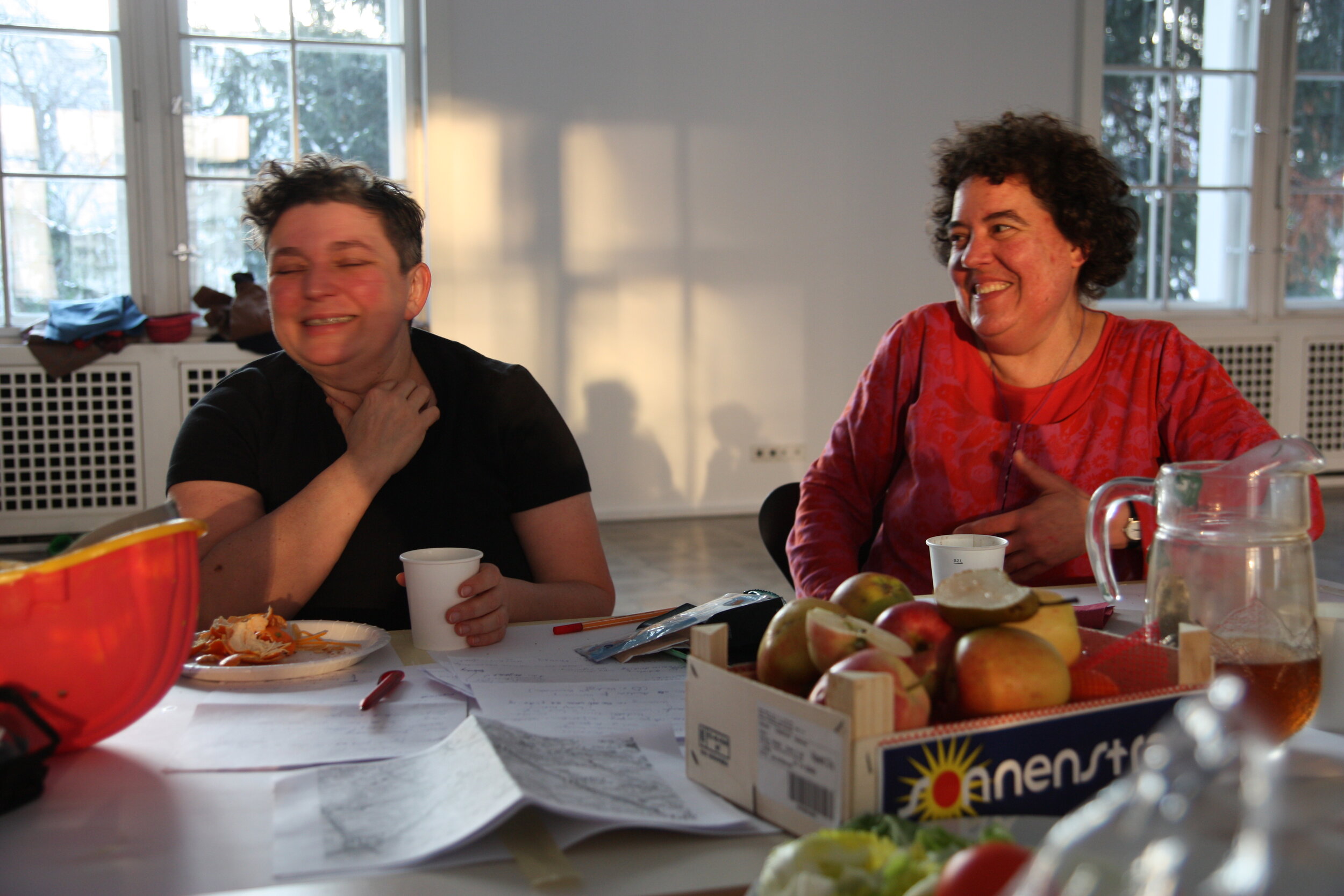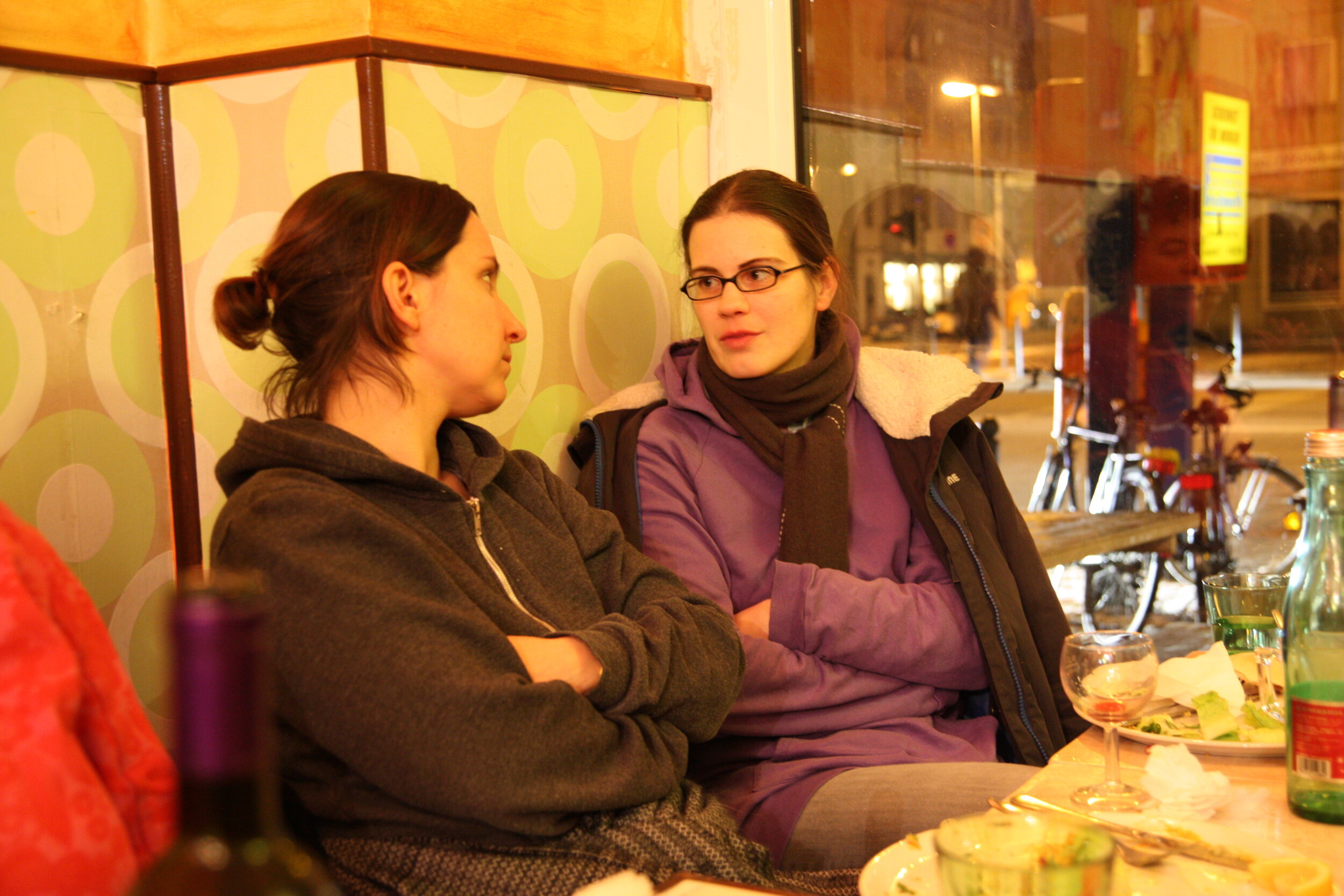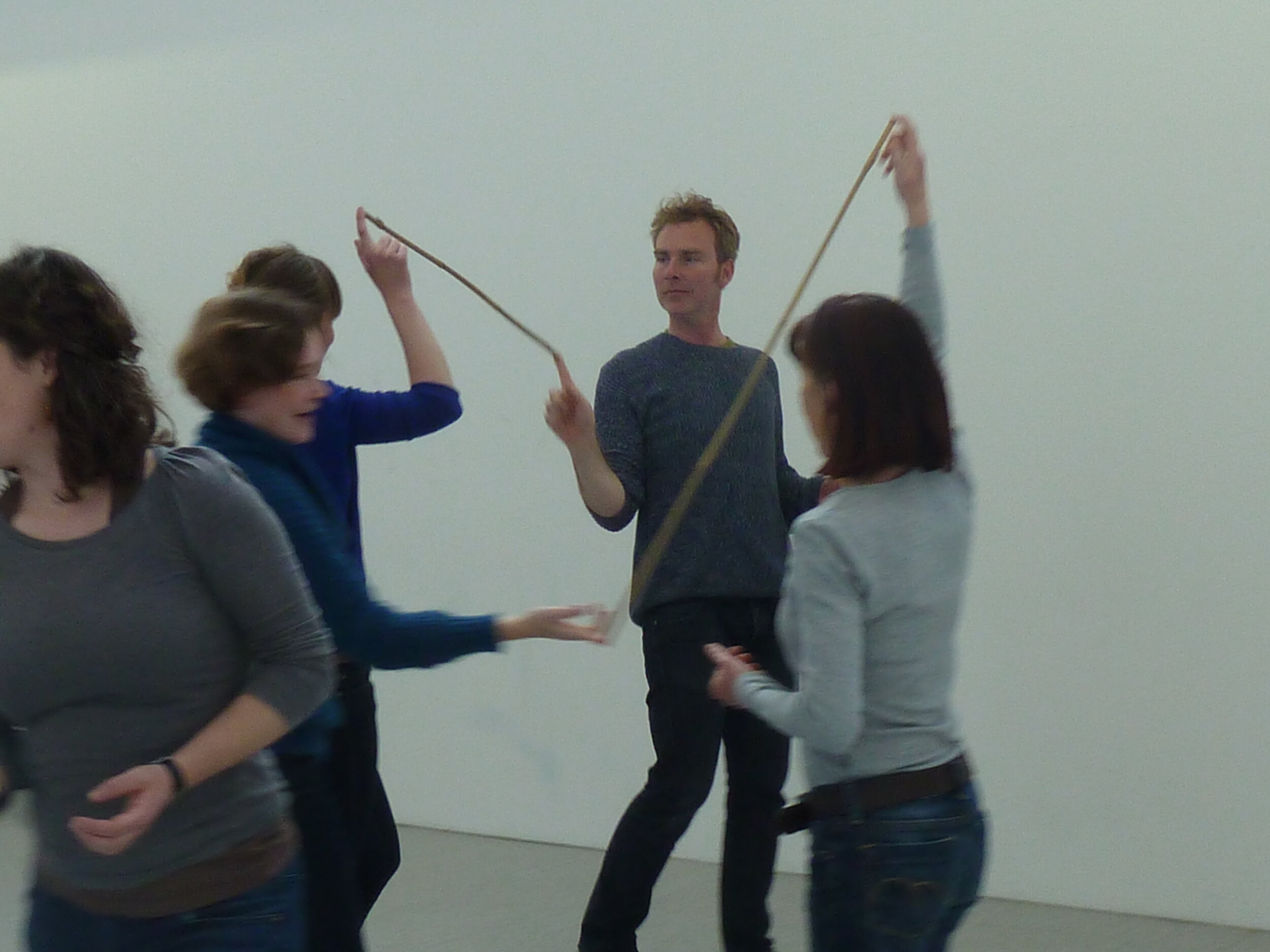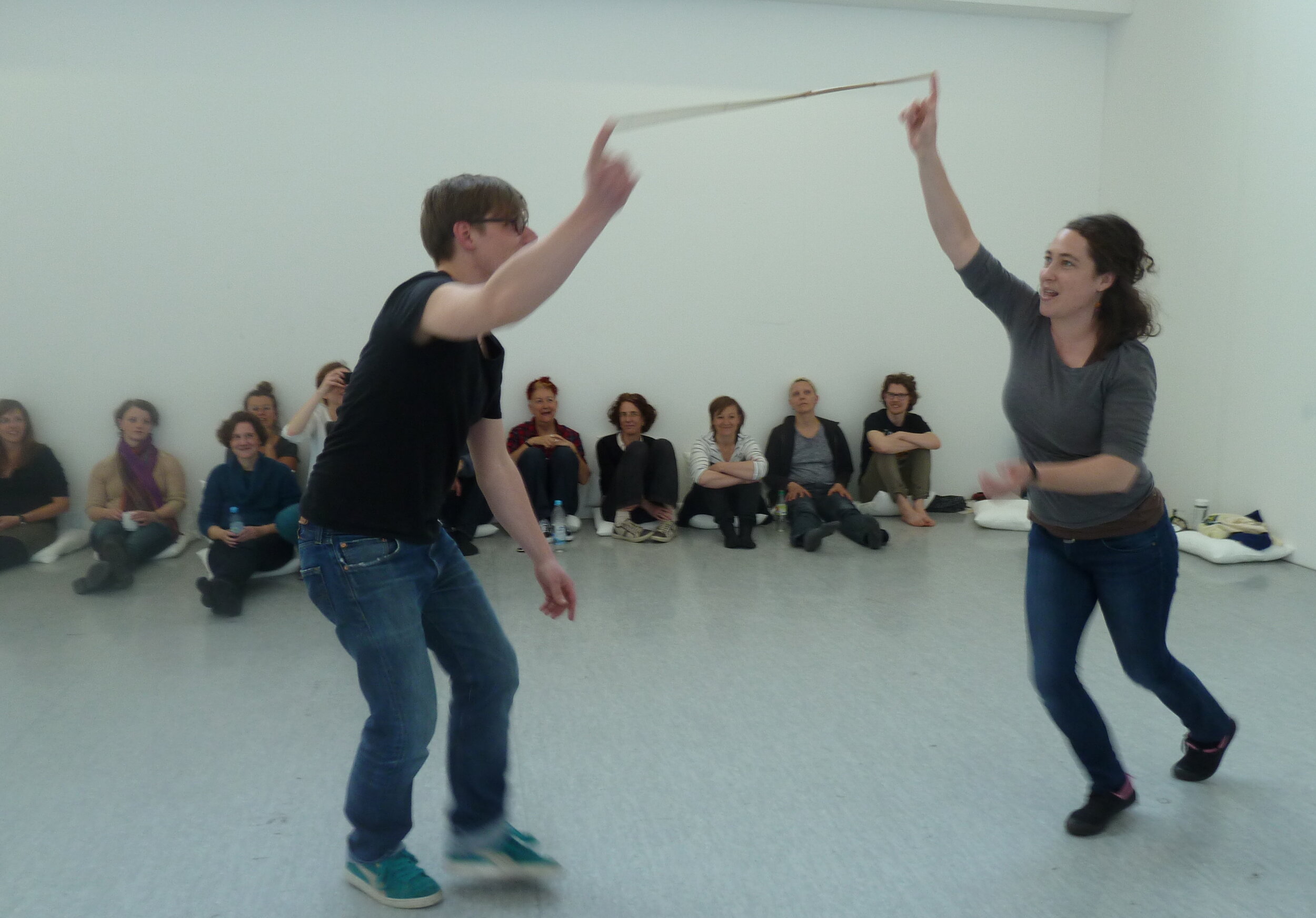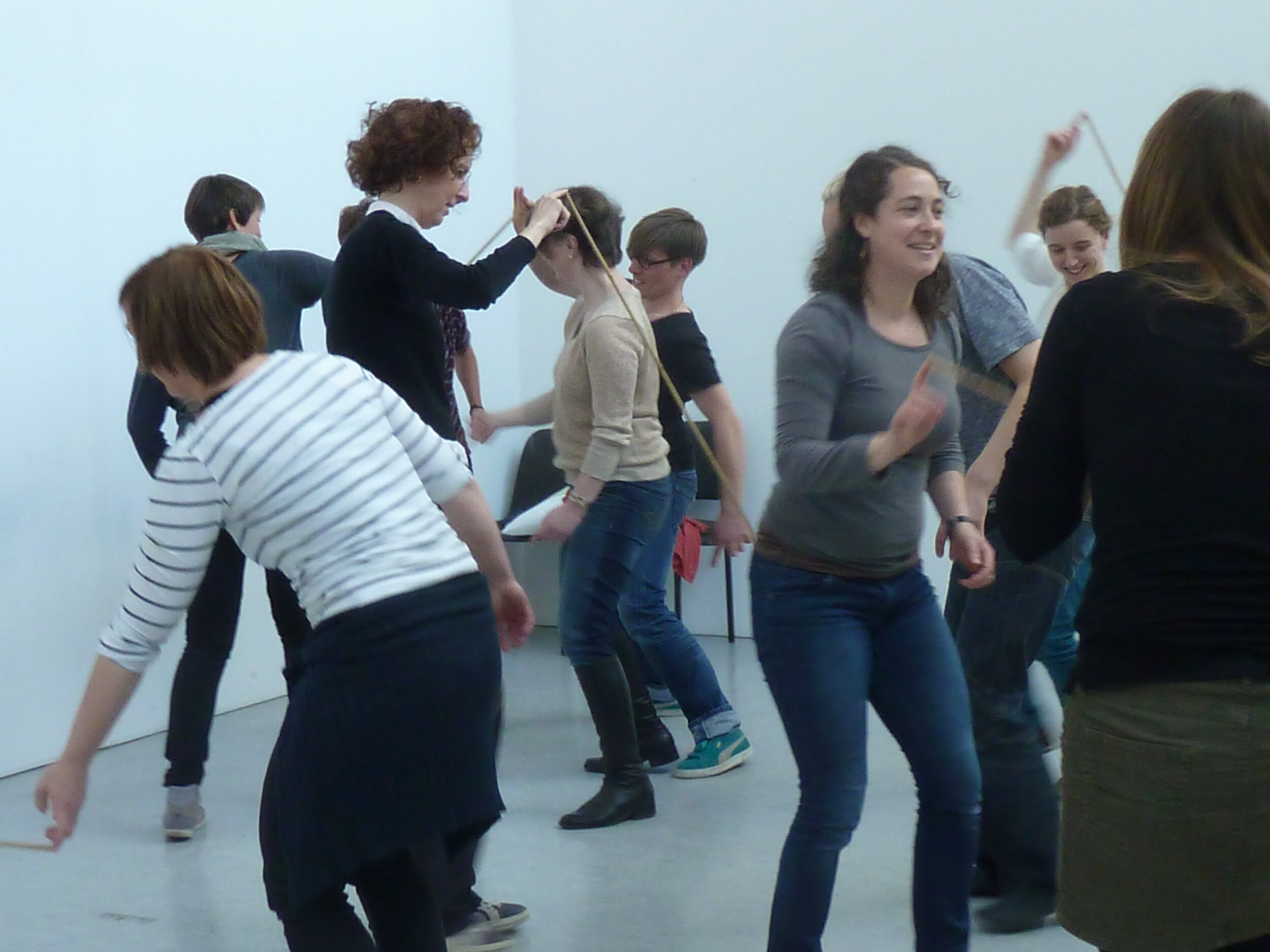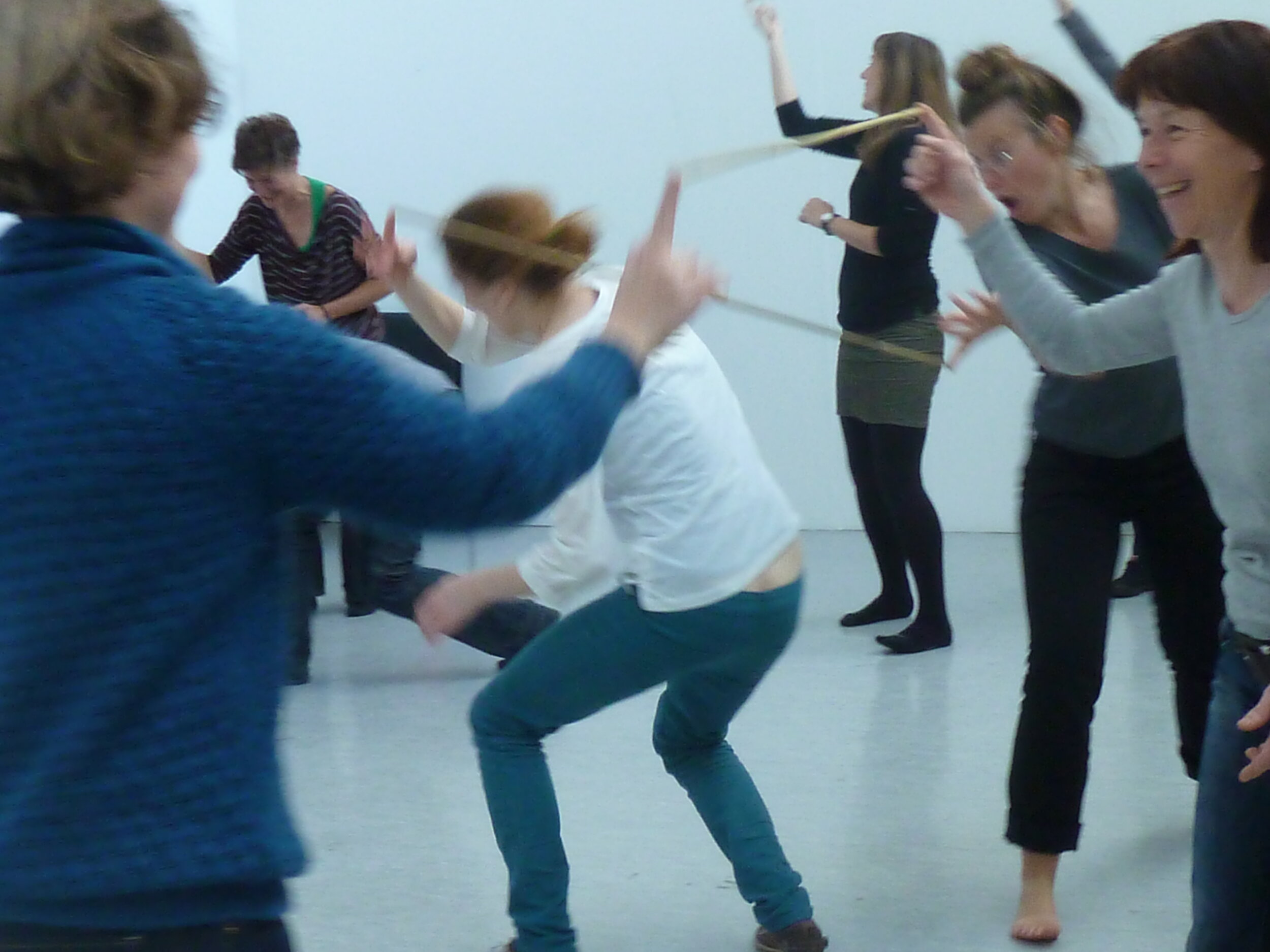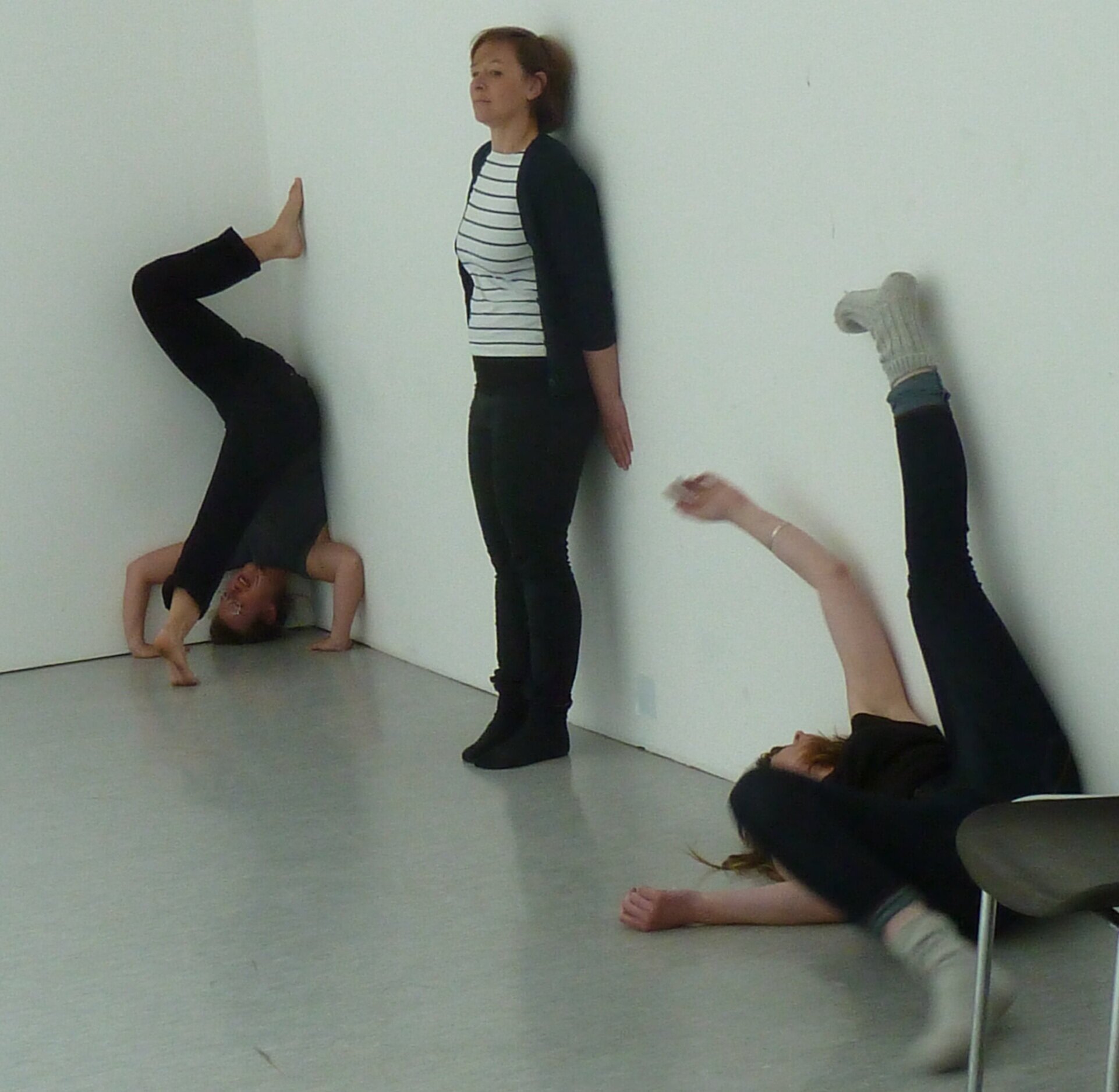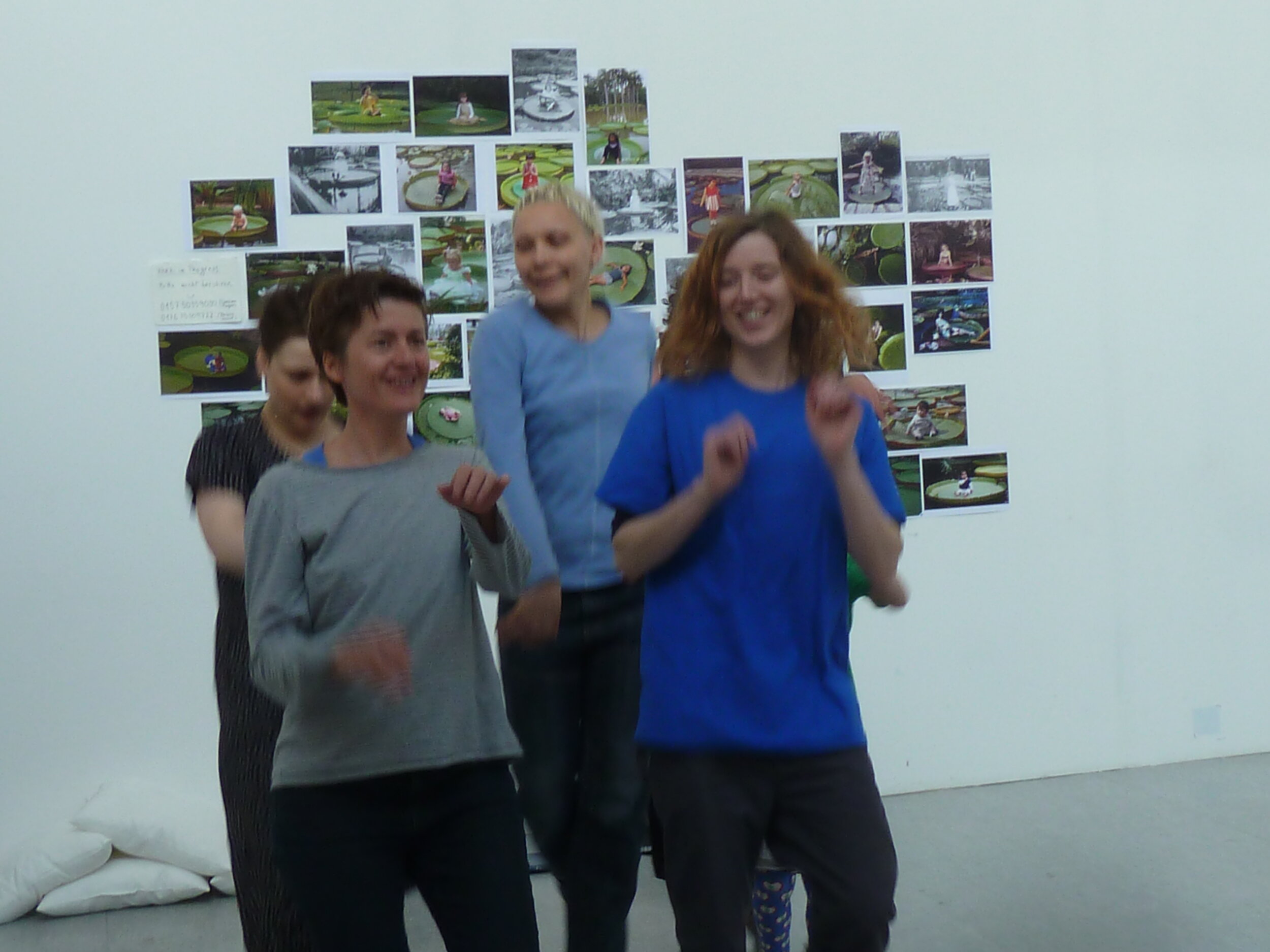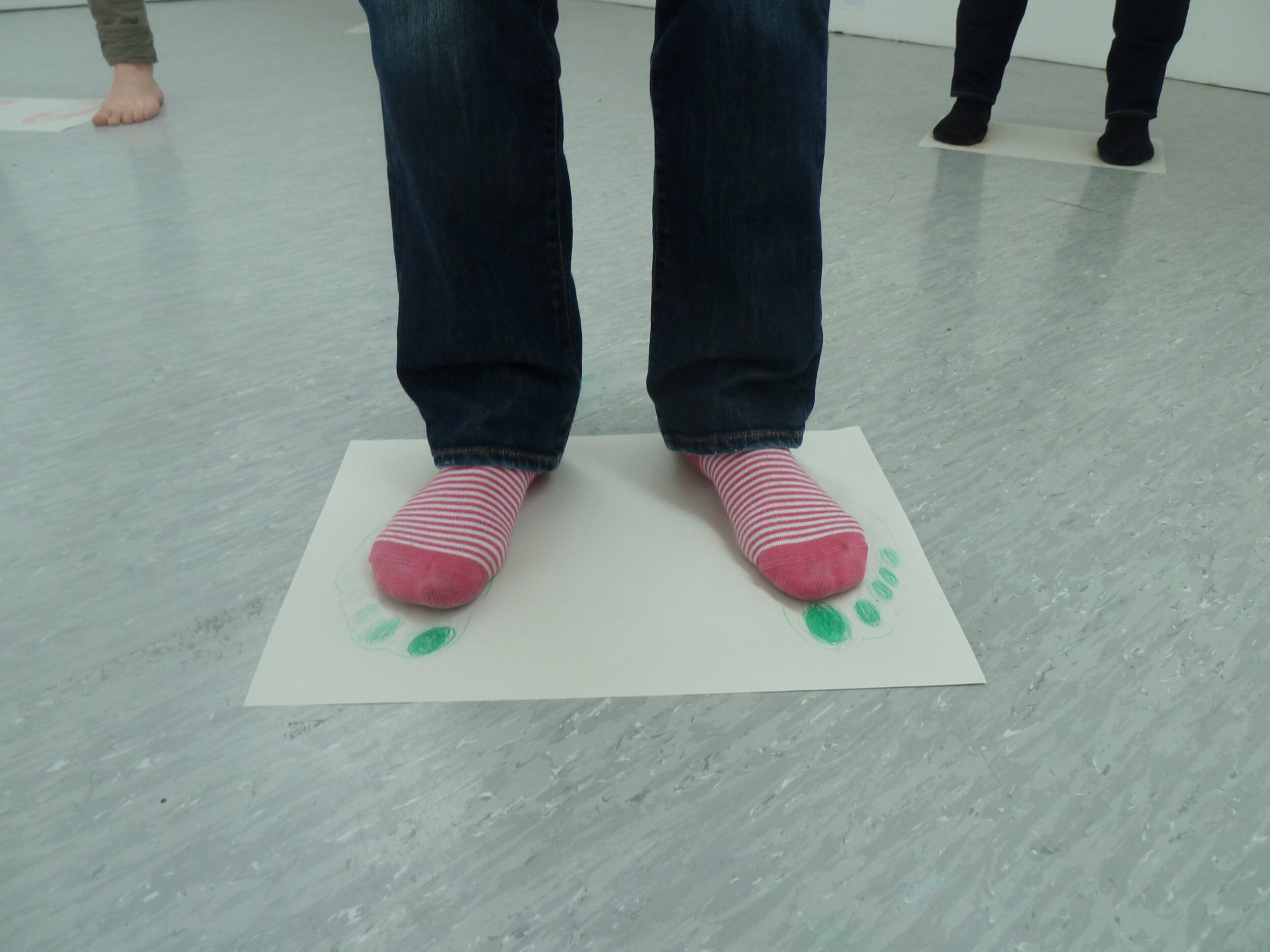clowning
We “aimed to make clowning dangerous again, to bring it back to the street, restore its disobedience and give it back the social function it once had: its ability to disrupt, critique and heal society.” CIRCA (2005)
Above: Mask created from photocopy of my face, used for puppets and for ongoing workshop publicity.
Research impulse: Being a co-founder and trainer of the Clandestine Insurgent Rebel Clown Army (CIRCA) from 2005 - 2008 brought together two strands of my arts practice at the time - clowning and feminist peace activism. I was able to develop a new, hybrid performance strategy - the rebel clown. This combined the naivety of the clown with the subversive parody of the buffoon. Inspiration for the Clandestine Insurgent Rebel Clown Army was provoked partly by the violence of global protests in Genoa during the 27th G8 summit, and partly as a response from activists who were tired of feeling burned out on anger, negativity and lost causes. Initially focussing on the G8 summits in Gleneagles in 2005 and later in Heiligendamm, Germany rebel clown gaggles sprouted up all over the world, and began to use the practice for local protests: for example, rebel clowns in San Diego formed the Boredom Patrol to counteract and parody the Minutemen patrols along the US/Mexican border. Finnish clowns worked against racist anti-migrant citizen patrols.
Simply (and successfully), CIRCA worked on the notion of subverting the binary relationships between protester and police, activist and authority, obedience and disobedience, permission and prohibition to redress power imbalances through humour and laughter. CIRCA captured activist’s imaginations because it offered a new method of subverting the binary between protester and authority and at the same time gave individuals and groups exciting and innovative methods to behave and act differently.
Clowning and rebel clown research practice continue to be places and states of empowerment where I can interrogate and interrupt these binaries through aesthetic practice-research, exploring the clown’s potential to subvert and turn life upside down.
The clown makes mistakes, compounds problems, is incompetent, fails triumphantly, makes people laugh at her….she represents everything that as a woman I am not supposed to be. As such she is an interruption in a hetero-normative perception of a successfully grown-up female.
Ya boo sucks!
From 2014 - 2018, funded by the Zurich Institute of Arts Education and the Universitåt der Künste, Berlin, as member of the group Queer Art Education: shifting dominant orders of identity/belonging, I facilitated a series of clown workshops, presented at seminars and created intervention/performances with arts educators and arts faculty members, artists and activists in the Hamburger Bahnhof Museum, Berlin.
(Photos above and below: Clown moments in the first two days of workshop trainings and interventions, April 2014)
The Hamburger Bahnhof Museum in Berlin is a prestigious and imposing institution, requiring a substantial walk to approach the front doors from the street. It is not somewhere you can just happen upon in passing, it is a place you have to know about and have to want to visit. How could a clown enter a museum? Our research during the four-day residency was to discover new ways and methods of approaching and potentially queering the art object: how could we interrupt perceptions and assumptions in the process of viewing and experiencing art specifically within a gallery or museum setting?
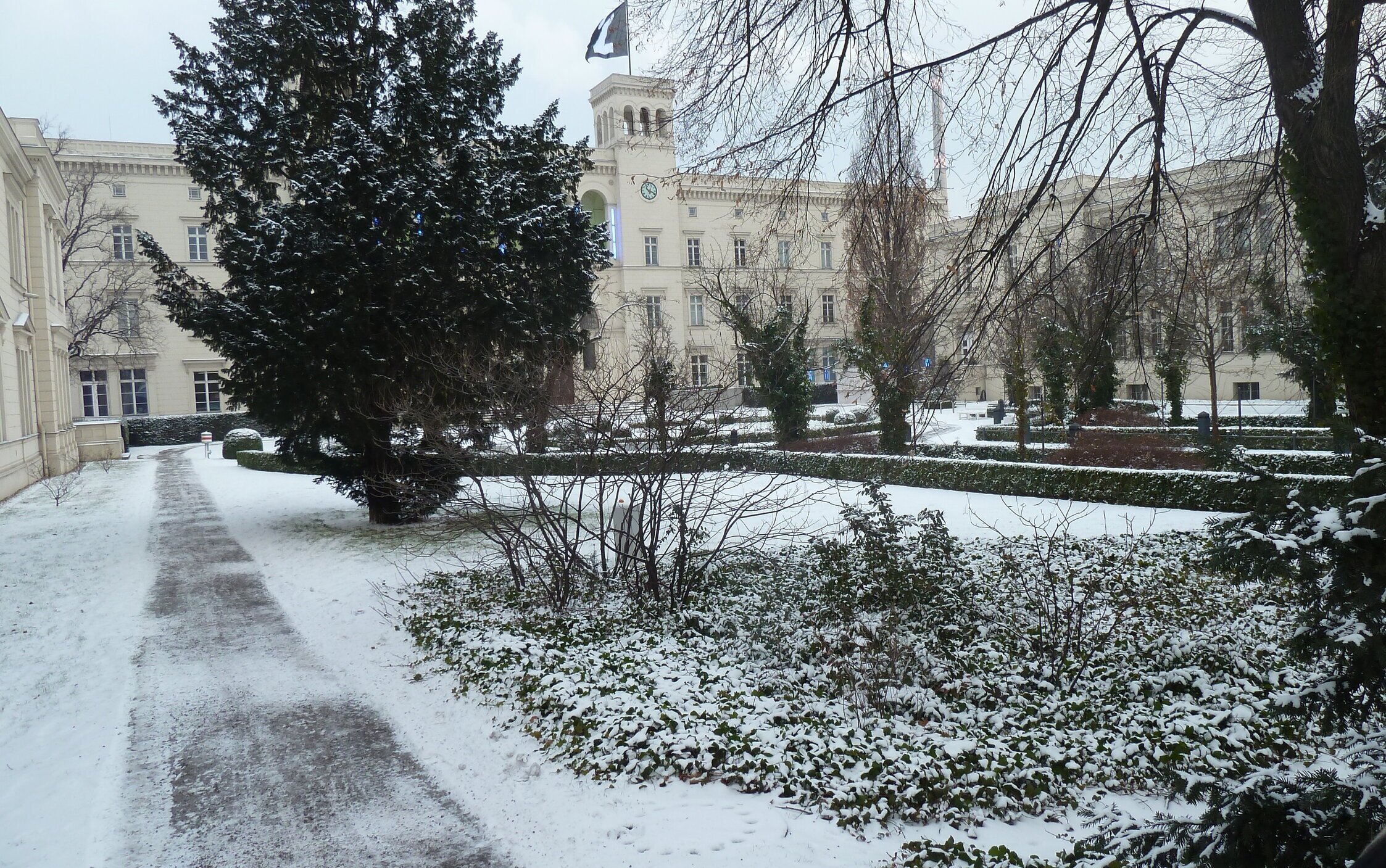
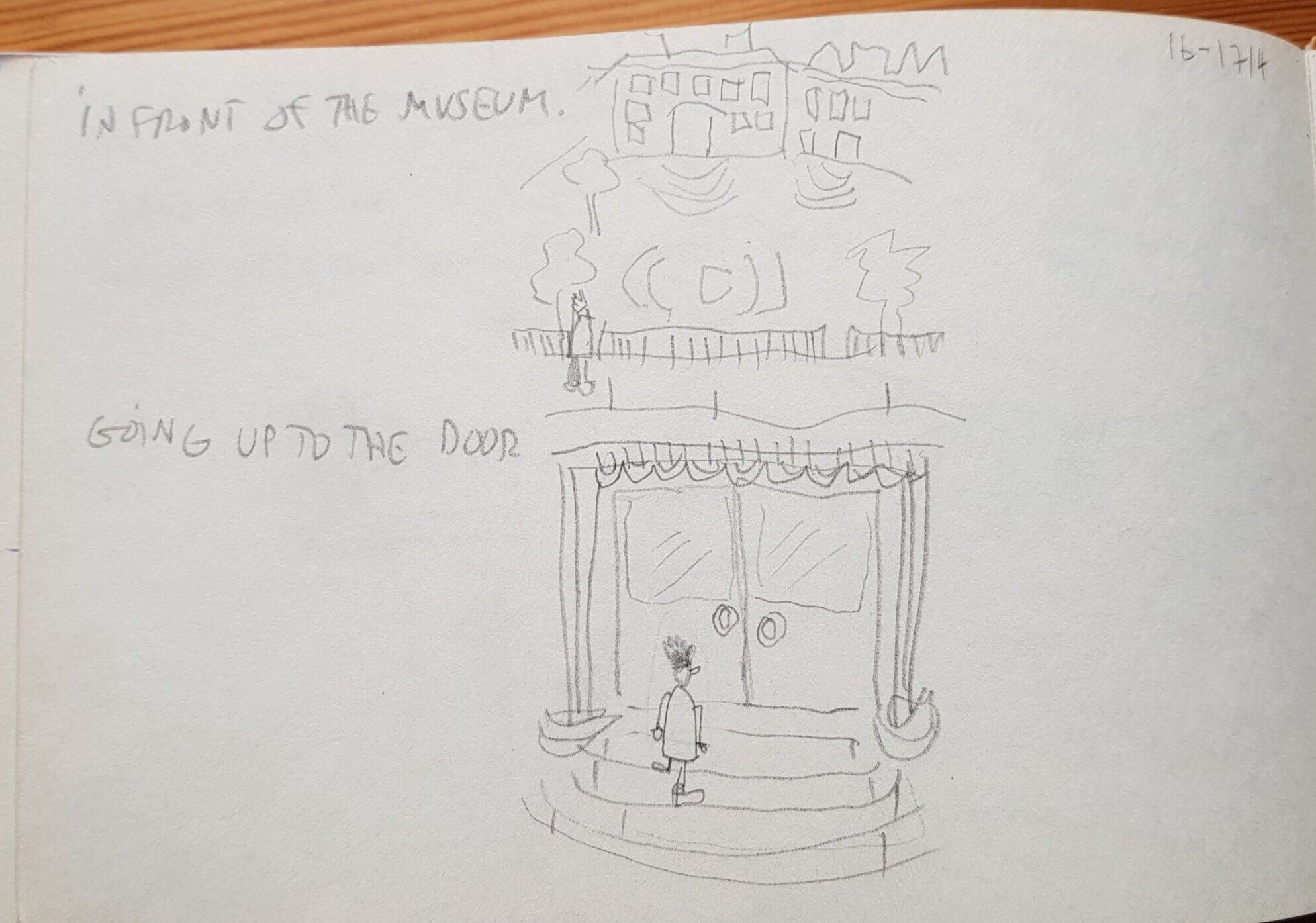
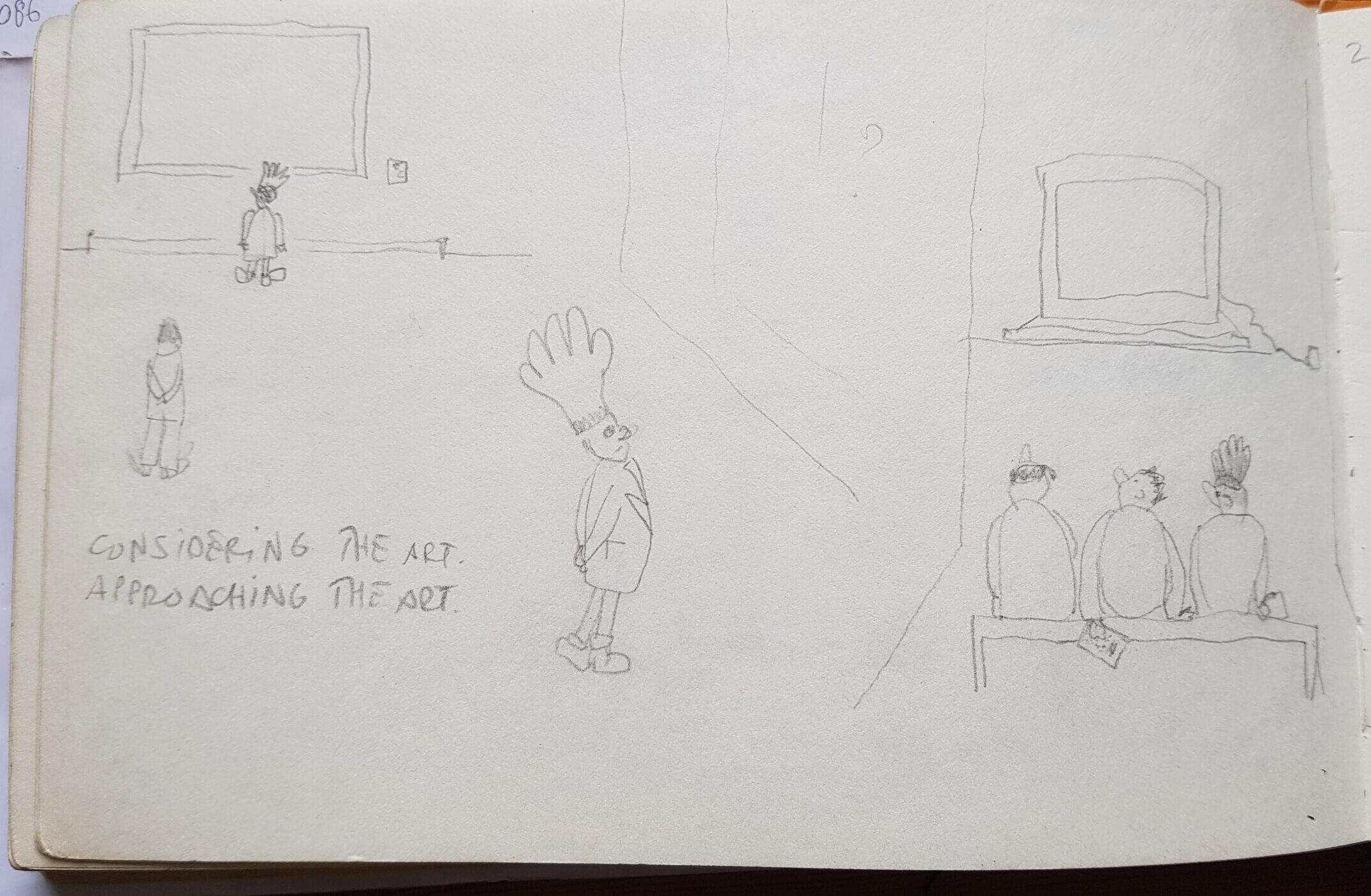
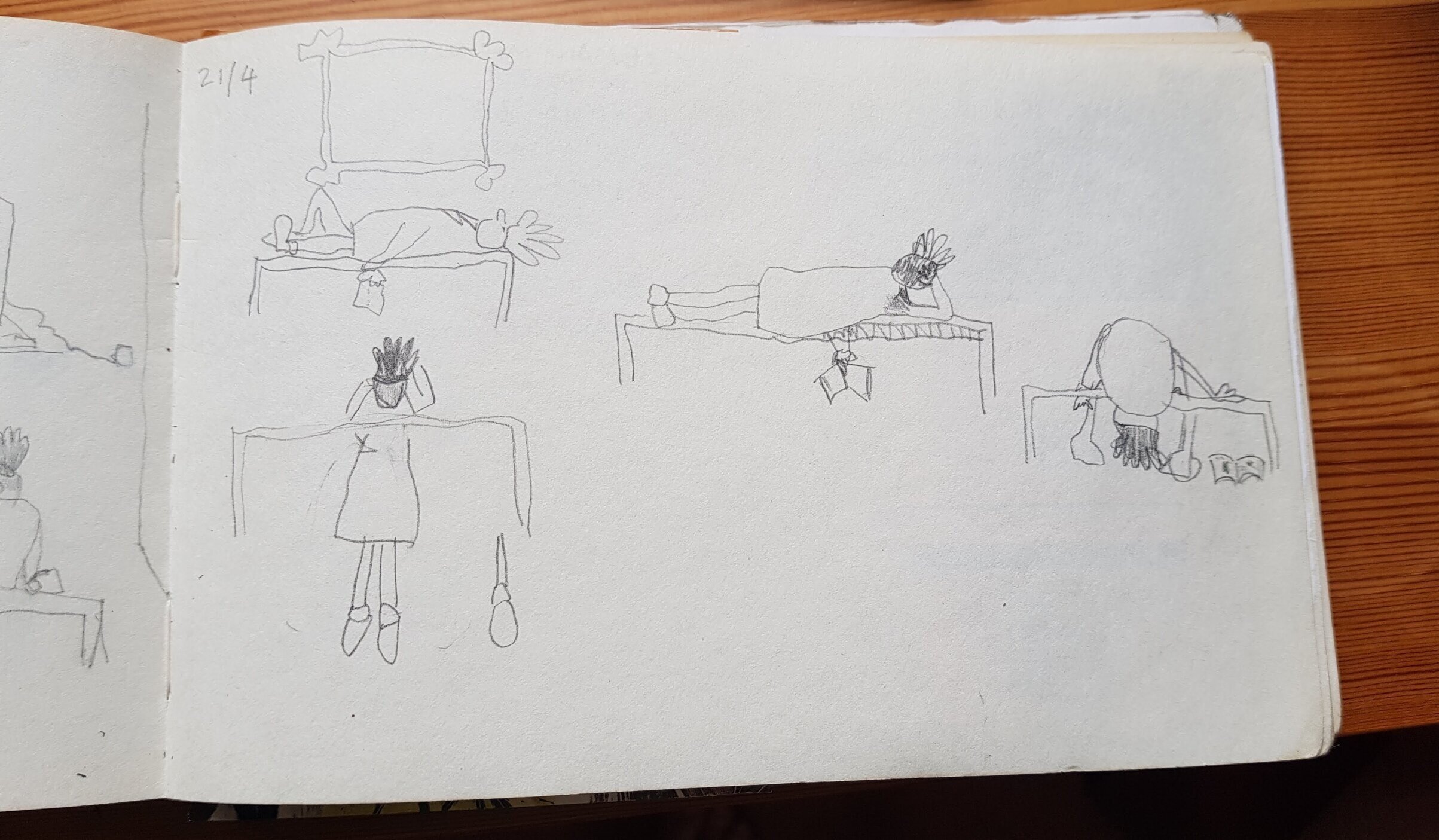

“This clown begins with nothing, is in fact ridiculous but is innocent of this fact, innocent of the impossibility of hope. To be ridiculous is normal, ridicule and loss is part of life, flopping, messing up, is inevitable” (Julia Salverson, 2006: 147).
The residency was organised as two days of clown and rebel clown training, followed by two days of ‘working’ (playing, intervening, interrupting, interacting) in the galleries of the museum. Our mission was to inhabit the naivety and openness of the clown, and to employ the subversive tactics of the rebel clown to question and disrupt. We set out to interrupt patterns of movement within the building and within the separate galleries, employing choreographed group walking and moving alongside other spectators. Dressed in our clown costumes we stood out and were also objects to be viewed and observed, on occasions to be played with. Spectators wondered whether we were the art objects, specifically hired to be part of the exhibitions.
Below: Clowns at work and play in the Hamburger Bahnhof Museum, Berlin, 2014
Turning the world (and art) upside down.
Clown play allows us to work with familiar elements in unfamiliar contexts, combinations and uses, additionally disassembling and reassembling past experiences and ways of working that might enable us to understand and respond differently to new and unexpected situations (Estrella & Forinash, 2007; Hargadon, 2002; Weick & Sutcliffe, 2001). Such bricolage (Barrett & Bolt, 2007; Hargadon, 2002) or assemblage (Deleuze & Guattari, 1992) where connections between previously unconnected elements or materials are made is reminiscent of the Situationist practice of détournement (Debord, 1955) where existing ideas and materials are juxtaposed and re-placed, with the purpose of enabling new associations – creative, intellectual, emotional and material. Objects and ideas are turned on their heads. Through play and détournement, existing assumptions and preconceptions are reconfigured and reframed. What or who is the art in the museum? Clowns look at the art, spectators look at the clowns, clowns play with and for the spectators.
Above: Clowns experimenting, playing and collaborating in the Hamburger Bahnhof Museum, Berlin, 2014)
In the world of the clown the equivalent of the Situationist détournement is clown logic or an alternative way of doing things that fails (by not adhering to or understanding normative rules) or succeeds (by inventing new rules). McManus argues that: ‘Clown logic does not appear to have an essential meaning other than to contradict the environment in which the clown appears’ (in Davison, 2013: 54). Ekaterina Moshaeva suggests that although the world is in a state of chaos ‘clowns are not afraid: chaos is their element. Through creativity and spontaneity they can alter chaos and make it lose its destructive nature’ (Davison, 2013: 304). Davison maintains that clowns act through intuition that is not bounded by a society’s rules or conventions. Clowns follow a logic that emerges from ways of perceiving and approaching questions and problems without the urgency to immediately solve them, but instead to find ways which unravel the threads of so-called rational thought.
Joseph Beuys alludes to the figure of the shaman or trickster, offering another perspective notions of a contemporary clown: “…when I appear as a kind of shamanistic figure…I do it to stress my belief in other priorities and the need to come up with a completely different plan for working with substances. For instance, in places like universities, where everyone speaks so rationally, it is necessary for a kind of enchanter to appear” (Tisdall, 1979). Clowning creates these alternative frames.
Above: Clowns moving amongst the artworks, observing the visitors, collaborating with the invigilators, Hamburger Bahnhof Museum, April 2014.
As we worked over the four days of the Museum residency, we developed subversive relationships with the low-paid invigilating staff: these people were not part of the Museum staff. They were precarious workers employed by an outside agency. They were not part of the Museum management nor the artistic teams and although they had been told not to interfere with our work, we learnt that they hadn’t been consulted or given much detail about what we were doing. We realised that this made their position and work within the Museum particularly difficult - after all they were employed to watch over the art and make sure nothing disturbed the spectators viewing of it. Our express purpose was to intervene and interrupt this process. Not wishing to endanger their status or to insult their work, we developed a kind of complicity with them - playing with them, and trying to help them feel more comfortable and complicit in our interventions. This kind of work is delicate and a significant element of clown play: it is crucial to obtain permission to intervene - that is not to say that the clown gives up easily when encountering resistance, rather the clown interrupts the pattern of resistance, finding a way around this either by making a fool of herself/themselves or by expressing disappointment at the rejection, which usually elicits a laugh, which then means the clown may continue.
Above: Clowns moving and playing amongst the artworks, observing the visitors, Hamburger Bahnhof Museum, April 2014.
Rebel clowning takes the subversion further: the clown’s naivety and willingness to please is layered with the cunning street wisdom and subversive parody of the buffoon/bouffon. S/he/they transgress/es boundaries of gender, intellect, sanity, activism and art: frequently neither male nor female, neither artist nor activist, clever nor stupid, entertainment nor threat. Ignoring and consciously ignorant of these oppressive binary oppositions s/he/they claim/s the position of the “other” with pride as s/he/they play/s with and against categorisation.
Clowning becomes rebellious. Within the museum we were at times parodying the visitor and the invigilator, with delicacy, asking for their permission by putting them at ease through our foolish and playful actions. The actions of invading the quiet space and the accepted choreography of the museum institution were less delicate, working as an ensemble, in harmony and with confidence, we more deliberately overstepped boundaries, pointing, laughing out loud, making noises of appreciation, disbelief and disgust depending on the feelings elicited by the artworks on display.
Being in the state of rebel clown, creates opportunities for new visionings and imaginations, emerging through a particular kind of embodied stupidity and clown logic.
What happens in the state of rebel clown? S/he/they interrupt/s her/their everyday self and assumptions, preconceptions and instead of merely confronting her/his/their opposition, (the visitors, the invigilators). S/he acknowledges their physical presence and gives them respect as fellow human beings. Here are the beginnings of disruption of power relations.
Photo left: Clowns in the Hamburger Bahnhof Museum, Berlin, 2014.
Parodying authority the rebel clown at once temporarily identifies with and assumes an identity of authority. Yet it falls short of contempt and mockery by the fact that the clown looks stupid and out of character. S/he/they allow/s fun to be made of her and her actions, no longer always having to say no in a directly binary confrontation.
Photo right: Clowns lying in the Hamburger Bahnhof Museum, Berlin, 2014.
Rebel clowning draws inspiration from a variety of practices and perspectives:
inspiration from the notion of carnival as a crucial form of resistance that merges the political and the aesthetic. Carnival is about joyful disruption, unpredictability and spontaneity. It’s about inventiveness and “offers the chance…to enter a completely new order of things”(Bakhtin, 1984: 34). The power of the carnival lies in its capacity to immediately transform reality and the political space itself.
Photo left: Clowns appreciate the art in the Hamburger Bahnhof Museum, Berlin, 2014.
inspiration from the bouffons, the outcasts of society (Gaulier, 2012) who are brought back into society once a year, to entertain the Great and the Good. The parodies are so acute, the laughter is so great that the elite audience of politicians, powerful capitalists and oligarchs, dies of massive heart attacks…..oops…oh dear…it is the killing joke…
Photo right: A pile of clowns in the Hamburger Bahnhof Museum, Berlin, 2014. Where is the art? Who’s watching whom? Who’s playing with whom?
inspiration from the clown who loves to make the audience laugh through her/their charm and failure.
inspiration from innovative personal-political approaches of feminism and queer activism and groups such as Reclaim the Streets and ACT UP. Instead of resisting, the clown collaborates; instead of obeying, the clown misunderstands. The humour and laughter that characterize the rebel clown are profoundly subversive, revealing a hybrid creature that falls outside the established patterns of resistance. (Feminism and Nonviolence Study Group, 1983)
Photo left: Where is the art? Who’s watching whom? Clowns looking at Chairman Mao in the Hamburger Bahnhof Museum, Berlin, 2014.
The clown moves to another exhibition space in the Hamburger Bahnhof Museum. She stares at a painting on the wall. It is upside down. She looks perplexed. She glances at the paintings on either side of it. She considers for a few moments. She then looks back at the first painting. She bends over to look at it through her legs. Not completely satisfied, she then turns herself completely upside down, in a handstand. This is not a ‘normal’ way to view art, but the clown follows her own logic – if the painting is upside down then I can look at it upside down. In doing so, in mirroring the art object, she performs an act of acrobatic beauty. She herself becomes an object to look at. Other spectators watch her look at art and also watch her become art. The space between the art, the clown spectator and other spectators is changed, offering new perspectives to be created and reflected upon.
At the end of each day of workshop training and interventions in the museum galleries we reconvened for long reflections (photos below).
Reflections were broad and deep:
Concerning permission: The museum gives us permission yet it is limited:
“Please come in and look; sometimes you may touch but we will tell you when you can do that. You may look in this way – from the front at what is on the wall; the in between part of the wall, where there is ‘nothing’ to look at is not important. Now you, the visitor, must move on, to another place to see something on the wall that is important, that we want you to see, that we allow you to see. Because there are a lot of other things somewhere in the museum that we don’t allow you to see. Someone chooses what we allow you to see.”
The rebel clown asks: Who is that someone? Who gets access?
Concerning Recognition: Aha! Here come the Clowns…we can recognize them by their Red noses, their Pink hats, their Funny costumes. That is ok, we know what to do, how to behave, because we know what they will do and how they will behave – it’s a mutual recognition and acceptance of modes, of norms, or rules. Are we, the clowns, then constrained to play by those rules? What if we play outside, beyond those rules?
Concerning attention: Is any attention welcome? Welcomed? Does the clown play with whatever she gets? Is that possible? The rebel clown plays with resistance, turning it into permission, turning cat into mouse, mouse into cat.
Concerning loitering: Waiting for something to happen. Hanging out, looking for the opportunity, the gap, the space, the pause, the Lacanian lack. No ideas – but an idea of a journey, the destination of which is unknown, the means of travel unknown. But I have my suitcase. It is full of some things. Waiting can be boring. The clown can express that boredom.
Concerning complicity: the clown enters into a complicit relationship with an audience – maybe that is the visitor to the museum. or the invigilator. I will do this if you do that. I will be funny. Whatever that means. What does it mean? The audience expects something….they enter into a relationship with the Clown, it is a contract. Negotiations. If you are this, I’ll be that, if you are funny this, I’ll laugh. But what if the clown is not funny?
As part of the project in I was commissioned to write a report: Clowning as arts education methodology, in which I explored the significance of employing clowning strategies and methods as arts-based research methodology to find new approaches and perspectives for artists and educators within arts education.
In 2015 and 2016, continuing with similar impulses, I facilitated workshops with artists and art educators from the Kontextschule, Universitåt der Künste, Berlin, which gave students new and playful methods to work with each other and to understand and develop each other’s practices.
Below: Students at the Kontextschule clowning workshops, Berlin, 2015
Working with play, improvisation and interrupting habits and patterns of behaviour, embodied action and thought, clowning and rebel clowning works on a number of levels - physical, emotional, spiritual and intellectual - to transform our normative perceptions of the world.
Below: Students at the Kontextschule clowning workshops, Berlin, 2015
Today interest in rebel clown practice is no longer confined to political activists: Architects and urban planners, geographers and musicians participate in workshops I facilitate - Storytelling and Activism, Cardiff 2017, Clowns in Crisis, 2020 - where interruption and subversion of normative tropes, systems and structures is key to developing new methods and methodologies within higher education and other institutions.
Clowns in full dress at the Kontextschule, Berlin, 2015.
Since March 2020 three clown colleagues and myself (Jon Davison, world-leading authority on the teaching, performance, history and theory of clowning, Robyn Hambrook, from the Online Clown Academy, Sabine Choucair of Clown Me In) have formed a group ‘Political Clowns’ to create new methodologies within clowning and in particular, to develop online clowning methods and innovative performance formats that can challenge social injustices and investigate our experiences of our rapidly changing worlds. Our research has been focussed on (but not exclusively) the following questions: Is rebel clowning still relevant and useful as a form of political protest and direct action? Is it still an innovative form of creative street action, that can inspire and build social movements? Does it continue to have the potential to access a deeper process for individuals that “liberates…..with weapons of love and laughter” (Klepto, 2004).
References:
Bakhtin, M. (1984 [1941]). Rabelais and his World. Indianapolis: University of Indiana Press.
Barrett, E. and Bolt, B., (eds). 2007 Practice as Research, Approaches to Creative Arts Enquiry. London/New York, IB Tauris
Davison, J. (2013). CLOWN, Readings in Theatre Practice. UK: Palgrave Macmillan
Debord, G. and Sanguinetti, G. (1972) transl. Christopher Winks (October 1972) Translation edited by NOT BORED! March 1998, Theses on the Situationist International and its time, Published in La Veritable Scission dans l’Internationale, Paris 1972, NYC: NOT BORED!
Deleuze, G. and Guattari, F. 1992. A Thousand Plateaus, Capitalism and Schizophrenia. London: Athlone.
Estrella, K. and Forinash, M. 2007. Narrative Inquiry and Arts-Based Inquiry: Multinarrative Perspectives. Journal of Humanistic Psychology, 47, 376-383.
Feminism and Nonviolence Study Group (1983). Piecing it Together: Feminism and Nonviolence. London: War Resisters’ International.
Fremeaux, I. and Ramsden, H. (2007). ‘We disobey to love, rebel clowning for social justice’, in Clover, D.E. and Stalker, J. (eds.), The Arts and Social Justice: Recrafting Adult Education and Community Cultural Leadership. Leicester, UK: National of Adult Continuing Education (NIACE), pp. 21–37.
Gaulier, P. (2012). Mes Pensées sur le Théâtre, My Thoughts on Theatre, Bondoufle: Éditions Filmiko.
Hargadon, A. B. 2002. Brokering knowledge: Linking learning and innovation. Research in Organizational Behavior, 24; 41-85.
Klepto, K. (2004). ‘Making war with love: The Clandestine Insurgent Rebel Clown Army’, City: Analysis of Urban Trends, Culture, Theory, Policy, Action 8 (3), pp. 403–411.
Tisdall, C (1979) Joseph Beuys. New York: Solomon R. Guggenheim Museum/Thames and Hudson
Weick, K. E. and Sutcliffe, K. M. 2001. Managing the Unexpected: Assuring High Performance in an Age of Complexity. USA: Jossey-Bass



